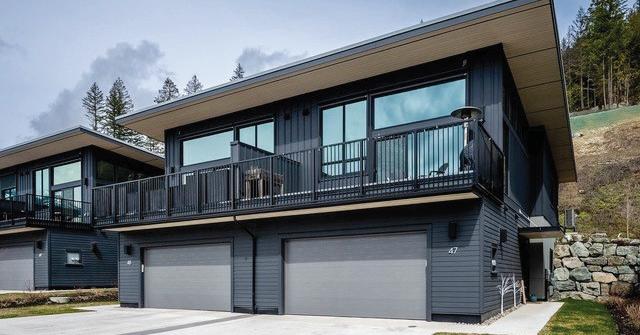In the NortherngrizzlyRockies, bears are on the move




As grizzlies recover, they’re no longer content to roam within the boundaries contrived for them
































































As grizzlies recover, they’re no longer content to roam within the boundaries contrived for them



























































As grizzlies recover, they’re no longer content to roam within the boundaries contrived for them. - By Gloria Dickie / High Country News
14 SLOW SUMMER The hard numbers are still out, but officials say summer 2023 is shaping up to be a slow one, by Whistler’s recent standards.
15 CALLS CLIMBING Whistler Search and Rescue says calls are beginning to ramp up after a slow start to the summer.
GUN
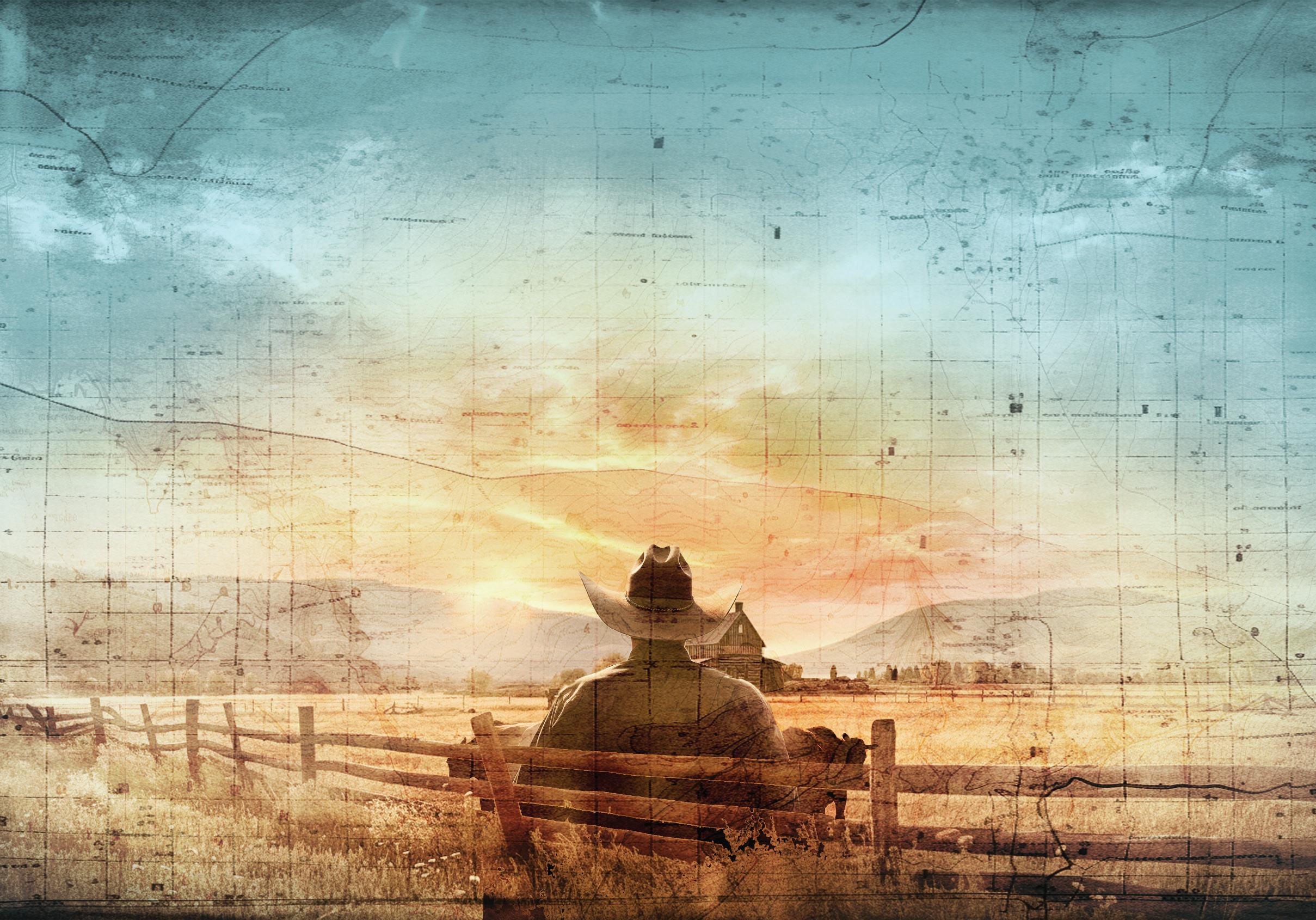
A family recounts their dramatic escape from a wildfire at Gun Lake, while the Squamish-Lillooet Regional District confirms three homes lost to the fire.

34
16 BEAR ENCOUNTER A local photographer is speaking out after watching a woman pull her dog into an encounter with a bear.
THE SPOT
The XTerra Whistler off-road triathlon is getting a facelift, with a pair of new September dates.

38 DIRTY DOZEN Whistler’s Flag Stop Festival, a hidden secret no more, returns to The Point Artist-Run Centre for its 12th instalment.
- By Jon Parris // @jon.parris.art






































Founding Publishers KATHY & BOB BARNETT
Publisher SARAH STROTHER - sstrother@wplpmedia.com
Editor BRADEN DUPUIS - bdupuis@piquenewsmagazine.com
Sales Manager SUSAN HUTCHINSON - shutchinson@wplpmedia.com
Production Manager AMIR SHAHRESTANI - ashahrestani@wplpmedia.com
Art Director JON PARRIS - jparris@wplpmedia.com
Advertising Representatives
TESSA SWEENEY - tsweeney@wplpmedia.com
GEORGIA BUTLER - gbutler@wplpmedia.com
Digital/Sales Coordinator AMELA DIZDARIC - traffic@wplpmedia.com
Production production@piquenewsmagazine.com
Features Editor BRANDON BARRETT - bbarrett@piquenewsmagazine.com
Arts Editor ALYSSA NOEL - arts@piquenewsmagazine.com
Social Media Editor MEGAN LALONDE - mlalonde@piquenewsmagazine.com
Reporters
BRANDON BARRETT - bbarrett@piquenewsmagazine.com
MEGAN LALONDE - mlalonde@piquenewsmagazine.com
ALYSSA NOEL arts@piquenewsmagazine.com
DAVID SONG - sports@piquenewsmagazine.com
Classifieds and Reception mail@piquenewsmagazine.com

Office and Accounts Manager HEIDI RODE - hrode@wplpmedia.com
Contributors G.D. MAXWELL, GLENDA BARTOSH, LESLIE ANTHONY, ANDREW MITCHELL, ALISON TAYLOR, VINCE SHULEY
President, Whistler Publishing LP
SARAH STROTHER - sstrother@wplpmedia.com
08 OPENING REMARKS Smoke ‘em if you got ‘em, writes editor Braden Dupuis—just pick up your butts and don’t start any fires.
10 LETTERS TO THE EDITOR
This week’s letter writers share thanks to the staff at the Whistler Medical Clinic, and call for an end to gas-powered leaf blowers in Whistler.

13 PIQUE’N YER INTEREST With Bill C-18, Canada is speaking loudly and carrying a small stick, writes Glacier Media’s vice-president of editorial Kirk LaPointe.
to deal with acceptable journalistic practices and ethical behaviour. If you have concerns about editorial content, please contact (edit@ piquenewsmagazine.com). If you are not satisfied with the response and wish to file a formal complaint, visit the web site at mediacouncil. ca or call toll-free 1-844-877-1163 for additional information. This organization replaces the BC Press council (and any mention of it).
ISSN #1206-2022
Subscriptions: $76.70/yr. within Canada, $136.60/yr. courier within Canada. $605.80/ yr. courier to USA. GST included. GST Reg. #R139517908. Canadian Publications Mail Product Sales Agreement #40016549.
28 RANGE ROVER Leslie Anthony retraces the familiar throughlines of the Trans-Canada Highway— and all the personal and historical memories that come with it.
36 EPICURIOUS Alpha Café, an offshoot of Whistler’s award-winning Alta Bistro, is set to open this month.

39 MUSEUM MUSINGS “Diamond” Jim McConkey is considered one of Whistler’s greatest icons— and his historical film collection backs it up.
54 MAXED OUT Max dives in to one of life on Earth’s greatest mysteries: do aliens exist? Get














LET’S GET the awful, no-good, disgusting part of this confession out of the way up top.
I love cigarettes.
If they weren’t so expensive, and if they weren’t literally cancer-inducing poison that made you smell like a mouldy ashtray, I would probably smoke a pack a day.
But in my defence, I only love cigarettes because I am brainwashed; a process that began at the tender age of 13, when my developing
 BY BRADEN DUPUIS
BY BRADEN DUPUIS
little pumpkin brain was still guided by a single, overriding instinct: to rebel.
So rebel I did, by ignoring all the best advice of my parents and elders and becoming a fully-fledged smoker before I had even hit the awful, embarrassing flourishes of puberty.
I smoked enthusiastically for 10 years or so, then spent much of the next 10 years trying to quit.

Today, I am fortunate to say I am no longer a smoker, but I know my nicotine addiction will follow me to my (hopefully not early) grave.
Let’s be clear: cigarettes are objectively terrible. There is not a single positive to being a smoker, and the negatives are too many to count.
It’s hard to imagine how anyone could ever consider it an enjoyable hobby (especially if you’ve never felt the pull of nicotine addiction for yourself, which some studies place on par with cocaine and heroin).
But then, cigarettes are quite literally brainwashing—a terrifying form of corporate mind control that alters the chemical balances of your brain and convinces you that slowly killing yourself is not only enjoyable, but a privilege worth thousands upon thousands of dollars annually.
It is one of modern capitalism’s greatest, most evil scams.
Luckily, we’ve been working to move
beyond it for decades now, and we’re still making progress.
According to the federal government’s most recent Canadian Tobacco and Nicotine Survey, about 10 per cent of Canadians were smokers in 2021 (on par with 2020, but down from 12 per cent in 2019). The prevalence of smoking in those aged 15 to 19 was about 3.3 per cent, down from five per cent in 2019.
According to the University of Waterloo, approximately half (!) of Canadians smoked in 1965, compared to just one in 10 in 2020.
As for electronic cigarettes, about five per cent of Canadians reported vaping in the past 30 days (which has mostly held steady since at least 2019). Of those, 12.7 per cent were aged 15 to 19, and 17.2 per cent were aged 20 to 24. Among both of those age groups, the prevalence of vaping increased slightly from 2020.
As someone with ample experience in both smoking and vaping, don’t kid yourself, kids: vaping is hardly any better for your lungs, and it still comes with significant long-
graphically illustrated the gruesome consequences of smoking since 2001 (I remember it well, as it was my first year as a smoker. A pack of darts cost me $7, if I could find someone old enough to buy them for me, and we were all furious when the price went up to $7.10; the price of a pack of cigarettes has more than doubled since then). If you’re still smoking in 2023, is the extra warning going to deter you? Probably not. But the idea is that young people who may be borrowing a cigarette for the first time will not be able to avoid the messaging, or that it may help encourage discussions about quitting among long-term smokers.
As a former smoker of nearly two decades, I will never begrudge someone their simple pleasure.
But if you’re the type of smoker to throw your butts on the ground, please, for the love of all that is sacred—stop.
I am far from innocent in this regard. In my early days as a teenaged smoker, I never thought twice about throwing my cigarette
are so welcome, sir).


According to Physicians for a Smoke-Free Canada, cigarette butts are made of cellulose acetate, a plastic with poor biodegradability. Butts thrown on the ground pose serious threats to wildlife and the environment, often finding their way into storm sewers and the water system, where they can kill fish, injure freshwater invertebrates, harm birds and plant life, and remain toxic for very long periods.

There are currently no estimates for how many butts are discarded into the environment in Canada, but about half of U.S. smokers surveyed said they threw cigarette butts on the ground or in a storm drain in the past month. And in 2019, legal manufacturers reported sales of 24 billion cigarettes in Canada.
That’s just the toxic impacts. There’s also the small matter of the fire risk, which, as our summers grow longer, hotter and drier each year, is only getting worse.
Even if you think it’s out, it might not be—
term unknowns attached. The only really healthy bet is to go straight-edge with that fresh mountain air.


The latest front in the war against Canada’s cigarette makers is branding each individual cigarette—which seems like overkill, and something about it is oddly amusing.
Each cigarette you smoke will soon be marked with phrases like “poison in every puff,” and “cigarettes damage your organs.”
Cigarette packages in Canada have
butts on the street or in the dirt, stamping them out and leaving them in my tread.
In the back half of my extended tenure, I at least had the courtesy to dispose of them properly (I’ll never forget an encounter in Whistler Village, in which a self-righteous man stopped to peer down from his high horse as I butted out and disposed of a cigarette into a trashcan on the Stroll. “Thank you,” he said, with a smug little smirk and an air of utmost superiority. You
as evidenced by a video from North Vancouver late last month, which showed a worker disposing of a cigarette butt in a backyard hedge, only for it to erupt into flames nearly seven full hours later.

The only safe bet, for the forests and for the environment, is to not leave them behind.
So, smoke ‘em if you got ‘em, and burn one in my honour if you’ve got ‘em to spare.
But please do us all a favour and pick up your butts. ■

[C]igarettes are quite literally brainwashing—a terrifying form of corporate mind control that alters the chemical balances of your brain and convinces you that slowly killing yourself is not only enjoyable, but a privilege worth thousands upon thousands of dollars annually.
Yo u r acce s s to l o c a l , p rov i n cia l a n d nat i o na l n ew s i s go i n g to b e revo ke d o n G o o g l e, Faceb o o k a n d I n s t a g r a m
A n d i t ’s n ot b e c au s e of a ny t h i n g we ’ ve d o n e.
Re ce n t l y, C a na da pa s s e d t h e O n lin e N ew s Ac t , a l s o k n ow n a s B ill C-18 , w h i ch ha s l e d to a s t a n d off b e t we e n t h e gove r n m e n t , G o o g l e a n d M e t a t h e pa re n t co m pa ny b eh in d Faceb o o k a n d I n s t a g r a m
B ot h G o o g l e a n d M e t a have s a i d t h ey p la n to cu t t i e s w i t h t h e n ew s i n d u s t r y i n C a na da a s a re su l t .
T h i s m ea n s M e t a w ill b l o ck t h e p o s t i n g a n d sha r i n g of o u r n ew s a r t i cl e s o n Faceb o o k a n d I n s t a g r a m . G o o g l e w ill a l s o re m ove li n k s to o u r si te s a n d a r t i cl e s in G o o g l e N ew s , D i s cove r a n d s ea rch re su l t s
T h ey ’ll a l s o c a n cel si g n i fi c a n t co n te n t li ce n si n g a g re e m e n t s a lrea d y in p lace w i t h o u r pa re n t co m pa ny, G laci e r M e dia .
U n d o u bte dl y, t h i s w ill have a h u ge i m pac t n ot s o l el y o n u s b u t , m o re im p o r t a n t l y, o n p e o p l e like yo u r s el f w h o may u s e t h e s e plat fo r m s to di s cove r w hat ’s ha p p e n i n g i n yo u r co m m u n i t y a n d to ge t co n tex t to eve n t s ha p p e n i n g in yo u r ow n back y a rd .
We ’re n ot p la n n i n g o n go i n g a ny w h e re, b u t h e re ’s h ow yo u c a n h elp:
1 . Sign up for our free daily newsletter by scanning the QR code. (And encourage your family and friends to do the same.)

2 . Follow u s o n Twit te r
3 . B ookma rk ou r we bsite a s th e h o m e pa ge o n you r d evi ces.
4 . Consider becoming a member if you aren’t already. Your suppor t will help us continue to cover local stories, by locals

5 . I f you own/op e rate a loc a l b u si n ess , co nsi d e r su p p o r ti n g loc a l by p laci n g ad s with 100% C a nad ia nown e d m e d ia outlet s , li ke u s .
W i t h yo u r h elp, m o re p e o p l e w ill b e a b l e to ge t t h ei r l o c a l n ew s fro m a t r u s te d s o u rce I n to day ’s a ge of m i si n fo r mat i o n , t hat ’s m o re i m p o r t a n t t ha n eve r.
T ha n k yo u . We a p p re ciate yo u .
Si n ce rel y, T h e Pi q u e N ew s ma g a zi n e tea m

I have just returned from the Whistler Medical Clinic’s emergency room, and I wanted to express my gratitude and reiterate my thanks to the people I encountered. My injury was small—I cut off the end of one of my fingers (not recommended for musicians, but it was the pinky on the right hand, so less horrendous).
Everyone I dealt with was professional, courteous, and almost as importantly, friendly and concerned. (This in stark contrast to my experience 20 minutes later with Whistler Blackcomb at the ticketing area.)
To end on a positive note, thank you. You take a lot of the hurt out of getting hurt.
Jeff Heintzman // WhistlerI realize that this complaint will fall on deaf ears, fume intoxicated minds, and technology-refusing, old-school blowhards; however, damn the torpedoes, I and all of Whistler would appreciate local landscaping
companies responsibly taking initiative to easily eliminate their beyond unpleasant noise and two-cycle engine exhaust pollution produced by gas-powered leaf blowers that they force upon Whistlerites, Whistler, and guests for the sake of company profit, refusal of health-serving innovation, and selfgratifying, chainsaw-thrilling noise-making in other people’s neighbourhoods.
Quiet, non-exhausting, affordable, practical, industrial and commercial grade, powerful, multi-speed, lightweight, compact,

1.5-hour-plus running charge, lithium battery-powered leaf blowers are available— there’s no longer a need for wannabe Harley Davidson riders and Paul Bunyan chainsaw leafs-men continuing to pollute Whistler and the world with their insufferable behaviour and same mentality.
Municipal hall doing something about it for Whistlerites/humanity? Fat chance— there’s no profit in it for fancy hotels, high-end restaurants, Vail Resorts, and McDonalds, etc., all business. It’s up to you, landscapers,


if you’re willing to see beyond profit, oldschool habit, and self-serving business mentality, and, instead, do something for humanity without having to be forced to act considerately and responsibly by petitioned, third-party, fine-enforced bylaw.
Robert Rust // Whistler










I enjoyed your feature on organic architecture (see Pique, July 28). I have worked in the energy conservation and renewable energy field since 1975, and while I am now retired, it is still disheartening to see the lack of meaningful progress for the past several decades. The demand for big, heavy, thirsty SUVs is probably the most visible manifestation of our lack of concern about the environment. In Vancouver, it is even more disheartening, as they plan mega communities with highrises that will require external energy sources for heating and cooling (passive solar heating is almost impossible in highrises) and massive concrete towers whose residents will be completely reliant on elevators.
I might add that many of these mega developments, such as the Jericho Lands, Burrard Bridge/False Creek (Senakw), UBC/ Pacific Spirit Park and Heather lands, are being proposed and built by First Nations and/or the MST Development Corporation (Musqueam, Squamish, Tsleil-Waututh). So,

I got quite a chuckle when I read the second paragraph of the feature, which stated that “Indigenous architecture was grounded upon maintaining harmony with the land in a deeply organic manner.” Not in Vancouver, and not in Whistler either.


 Wally Raepple // Whistler
Wally Raepple // Whistler



We would like to recognize the following people and businesses for their generous contribution to support the Gun Lake Fire Protection Society and its volunteers in their tireless efforts working on the Downton Lake wildfire. A HUGE thank you to: Whistler Blackcomb; Creekside Market; Nesters Market;


The Gun Lake Ratepayers Association (GLRA) is a non-profit society whose main purpose is to promote, encourage and engage in the conservation, preservation, enhancement and stewardship of the Gun Lake Watershed on behalf of its area residents, registered landowners and recreational users.
Slope Slide Supply Ltd.; Jared Bunko; the Akehurst Family; and the Kazimirski Family. And special thanks to Lindsay Coleman and Mark Roehlig at the Valley General Store in Gold Bridge for staging all the food and drinks donated.
Barbara Rose // On behalf of the Gun Lake Ratepayers Association n

Write to us! Letters to the editor must contain the writer’s name, address and a daytime telephone number. Maximum length is 450 words. Pique Newsmagazine reserves the right to edit, condense or refrain from publishing any contribution. Letters reflect the opinion of the writer and not that of Pique Newsmagazine. Send them to edit@ piquenewsmagazine.com before 11 a.m. on Tuesday for consideration in that week’s paper.

“There’s no longer a need for wannabe Harley Davidson riders and Paul Bunyan chainsaw leafsmen continuing to pollute Whistler and the world with their insufferable behaviour and same mentality.”
- ROBERT RUST
WCSS is looking for diverse and strategic thinkers who have the capacity and interest to grow into a leadership role. WCSS is particularly interested in people with either lived experience or formal skills in t he following areas:


- Familiarity with WCSS Programs

- Social Services Experience

- Community Involvement
- Community Connections


- Understanding of Community Needs

New Board Directors must be able to attend a monthly Board meeting (can attend virtually), participate in at least one committee, and possess willingness and time flexibility to take on additional hours as necessary to support the work of the Board
To apply, please submit:
- Board Director application for m available at: mywcss.org/about-wcss/employment/

- Current resume and references (optional)
Application Deadline: August 18, 2023

Terms for Directors are two years and typically begin after the AGM at the end of June Board meetings are held on the last Wednesday of each month
All applicants will be contacted.
If you would like assistance with the application process, interview readiness or tips for resume and cover letter writing, send your question via email to gov chair@mywcss.org and we will make a WCSS Board Director available to you as an advisor
WCSS is dedicated to diversity, inclusion and antiracism Our commitment is reflected in our programming, the clients we engage with and the team members we employ. We encourage a workplace in which individual differences are recognized, appreciated and respected
We welcome applications from all qualified candidates.



T HE FEDERAL GOVERNMENT still would like us to think Meta and Google are bluffing about cutting news from their platforms.
The federal government still would like us to think Canada can “lead the world” in standing up to the tech titans.

The federal government still would like us to think its Bill C-18 will save local journalism.

Stubbornly fixated on these myths, the Trudeau administration found itself outflanked last week as Meta did what it had promised all along but the government just wouldn’t believe.
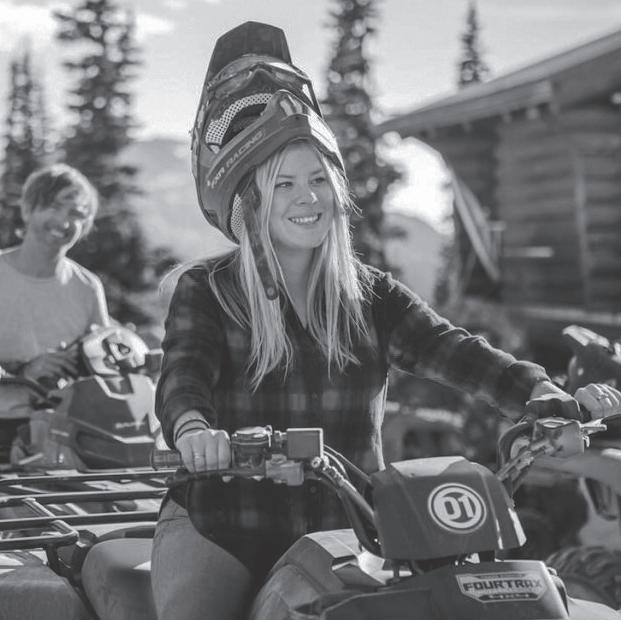

Hour by hour, for weeks to come, news accounts on Facebook and Instagram will gradually shutter and traffic will disappear. Negotiated payments to publishers are on notice to cease. First Meta, then Google will not let Canada set the precedent—“lead the world,” if you will—by taxing each news link they carry and, in legislating so, encouraging other countries to follow suit.

That scheme, that dream, stops here and now.
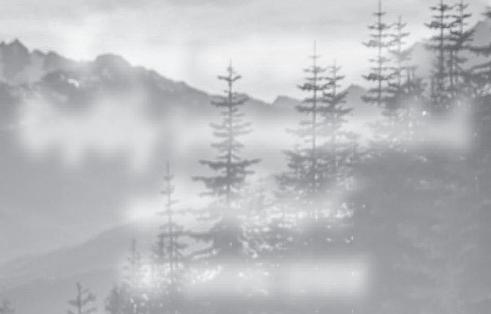

Over decades, Meta and Google

disrupted journalism’s best-laid digital plans by commandeering through their technology stacks the lion’s share of advertising once the preserve of traditional media. News is today only a slender part of how they deliver advertising—a good vehicle, but not necessary for their platforms to thrive.


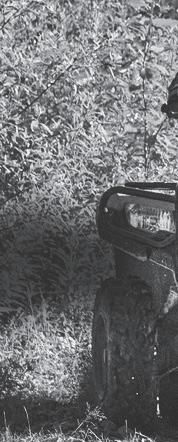

Rather than pay a tax with no ceiling on the amount, Meta and Google have concluded they can simply scrap news in Canada on their platforms and skirt a big headache. And they have a point the government won’t acknowledge, much less accept: that, far from threatening journalism, they have helped it find a digital audience it would not have otherwise through search engine results or in their feeds.

It has proven relative peanuts to them, but the main course to media.
In crafting C-18, the Trudeau government naively thought it had uniquely found a financial solution for digital journalism. If publishers needed a boost, it thought, taxing the behemoths posed the solution. It assumed Meta and Google had no choice but to capitulate.

Instead, as Meta walks away and Google seems ready to follow, it is time the government realizes it has crafted the worst of all worlds—the end of existing

agreements between dozens of publishers and the tech giants and the suffocation of the majority of digital consumption that finances journalism.
The result would be as if journalism’s business model were set back three decades to an era of newbie websites with small audiences—only this time with a wounded newspaper business. If Meta and Google scrap news, it will be necessary to build an audience and a sustainable revenue stream all over again. Bookmarking will come back.


Without a trace of chagrin, government has pledged—but is vague about how—it will make media whole if the tech firms make good on the threat.
This brinksmanship does nothing to help an uncertain Canadian local news environment. Bell Media wants the federal regulator to quash its local news requirements; if it succeeds, get ready for a broadcast stampede. Conservatives sound serious under Pierre Poilievre about a true reboot of CBC if elected; the idea is certainly helping their fundraising.
As if the bill’s passage weren’t menacing enough on journalism, last week Trudeau shuffled his cabinet just as sensible conversations were emerging. It appeared Meta and Google were working through their concerns with the government, with
a likely outcome of a much larger fund for journalism organizations—but no tax. It may not have been of assistance that Pascale St-Onge, a former media union leader moved into the heritage minister’s job, vowed to continue the fight against the titans as the local news saviour.
It’s unclear if Meta’s move is a bargaining stunt or, more likely, part of a larger effort to get out of the news field worldwide for Instagram and its 3 billion Facebook users. Google seemingly has more interest in keeping news part of its search engine’s authority but it, too, will not accept the tax.
Why would they? If they capitulate here, there are dozens of countries clamouring for their own C-18s. The tech behemoths want to make a point, first with Canada and by extension the world, that they have little to lose when news goes missing.
For the time being, though, the Trudeau government thinks it has framed the issue as Big Bad Tech getting its Justin desserts. Won’t happen. This isn’t the fix on the runaway powers of the platforms.
Canada is speaking loudly and carrying a small stick.
Kirk LaPointe is publisher and executive editor of BIV and vice-president, editorial, of Glacier Media. n
AS HOTELS REDUCE PRICES TO BOOST DEMAND, TOURISM WHISTLER CONFIRMS VISITATION IS TRENDING BELOW PRE-PANDEMIC LEVELS
BY MEGAN LALONDENO, YOU’RE NOT imagining it: this summer is shaping up to be a relatively quiet one, by Whistler’s standards.
Despite crowds of guests still hitting the Village Stroll each weekend, Whistler Chamber of Commerce executive director Louise Walker recently confirmed various sectors across the resort are indeed experiencing a “softer” summer season compared to prepandemic years.
The tempered visitation in Whistler since the snow melted isn’t exactly a shock to tourism operators. Back in May, preliminary numbers prompted Tourism Whistler president and CEO Barrett Fisher to predict this summer season would finish behind summer 2019 in the record books. So far, “Performance data to date confirms that forecast to be accurate,” she explained in an emailed statement.
The six months spanning May 1 to Oct. 31 in 2018 remain Whistler’s busiest summer on record, due in part to a packed events calendar dotted with festivals like Wanderlust and the Canadian National BBQ Championships,

plus races such as Ironman, Red Bull 400, and Tough Mudder. Room-night bookings in the resort dipped about two-per-cent the following year, before COVID-19 threw the global tourism industry into a tailspin in 2020.
While Fisher credited conference groups with helping “buoy overnight visitation” throughout May and June this year, she said booking rates for July and August continue to pace behind those pre-pandemic levels.
“July and August are typically more
expected.”
In response, she said Tourism Whistler has directed more marketing dollars towards British Columbia and Washington state this summer, encouraging Pacific Northwesterners to consider a midweek visit before the cool weather hits.
But the slowed-down demand isn’t affecting Whistler’s overnight accommodation providers equally, said Melanie Keam, general manager at Delta
slight uptick in visitation when it took over the resort for 10 days each August, Keam said. Now, “the pace across the two months seems to be more even,” she explained.
In response, “most hotels are responding to the consumer,” and lowering their prices accordingly, Keam said.
On the bright side, Keam said Whistler’s hotels appear to be better-staffed compared to previous years, based on discussions at the hotel association’s most recent meeting.
“The number of applicants has drastically improved … so most hotels are staffed up to be able to manage any level of demand that comes in,” she said.
“It’s the first time in a while we’ve been able to say that.”
Still, Walker said labour generally remains a challenge for many Whistler businesses. She estimated only about onethird are fully-staffed, with most of the remaining players between one and three employees short of a full roster.
leisure-travel focused, and we can attribute the weakened demand to various factors such as global economic uncertainty, increased interest rates, higher overall travel costs, and travellers staying closer to home or prioritizing different vacations that they were unable to do during the pandemic,” she explained.
According to Fisher, Whistler has “seen a reduction in international visitation, which is typical in times of economic instability, and U.S. visitation to Canada has been slower to return post-pandemic than originally
Whistler Village Suites and chair of the Hotel Association of Whistler.
“We’re seeing some variation, depending on the size of the hotel, with bigger hotels pacing slightly better and smaller hotels and unbranded [accommodation providers], in particular, faring slightly worse,” she said. “But overall, I would say there has been a softening in August, for sure.”
Keam attributed that to Crankworx shifting to July this year. Typically, the mountain biking festival brought about a
Walker acknowledged there’s been “a small improvement from the winter season,” but maintained Whistler’s current staffing levels remain “far from ideal.”
But will those businesses see lower-thanpre-pandemic visitor volumes carry forward into the fall and beyond? Keam isn’t so sure.
“I don’t know,” she said. “Just because Whistler has such distinct seasonality and such different customers who come from season to season, I wouldn’t say I’m ready to bank on this trend of softening demand continuing into future months.” n
CROWD CONTROL Crankworx crowds packed into Whistler Village to watch the Red Bull Joyride on July 29. In previous years, the festival took place in August, bringing about a corresponding bump in Whistler’s visitation levels. PHOTO BY ROB PERRY / COURTESY OF CRANKWORX“July and August are typically more leisure-travel focused, and we can attribute the weakened demand to various factors...”
- BARRETT FISHER
VOLUNTEERS RESCUED AN INJURED CLIMBER FROM MOUNT WEART
ON JULY 26
BY MEGAN LALONDEIN A TYPICAL YEAR, Whistler Search and Rescue (SAR) receives about two or three calls to help climbers who find themselves lost, stuck or injured in the backcountry.
This summer, volunteers have instead responded to three climbing-related calls “in just the last few weeks” alone, according to Whistler SAR president Brad Sills.
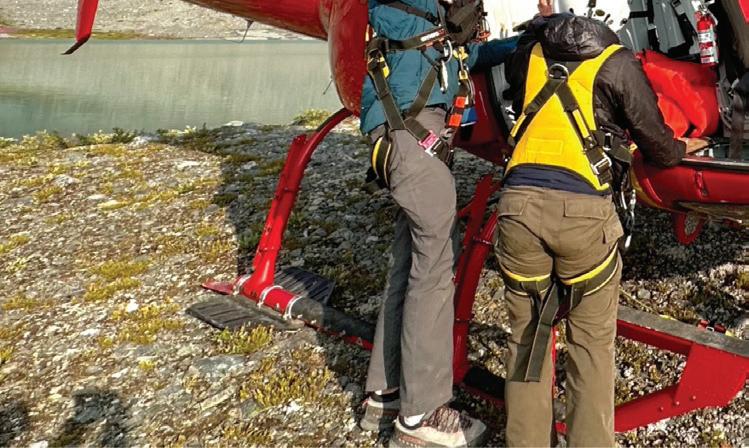
“We’ve had a sudden reemergence of climbing as an activity that we respond to,” he said. “We’ve not been hugely involved in that over the past decade.”
Crews rescued one of those subjects on July 26 from Mount Weart, near Wedgemount Lake in Garibaldi Provincial Park. Rescuers extricated the woman, who Sills estimated was in her late-20s, via a helicopter and longline from a ridge about 200 metres below the peak’s summit. Part of a party of three, she was scrambling up a four-metre vertical pitch when she fell and landed on her hip, sustaining painful injuries in the process, Sills said.
Fortunately, she landed on the mountain’s narrow ridge, and didn’t fall off either side of the arête. “Likely, she wouldn’t have survived that,” Sills said. “She realized just how close she came.”
The incident “kind of reflects the changing face of mountaineering in the South Coast,” he added. “Back in the ’70s, that route—or certainly for good portions of it—you were roped, and it was deemed to be, like, a Class 4 or 5 scramble with lots of exposure. Now, it’s fairly common to see trail runners on it, in just running shoes and lycra shorts and a cellphone.”
In recent weeks, Whistler SAR also responded to two mutual aid calls from Pemberton SAR: one to help a lead climber who was stuck after veering off-route near Marble Canyon, and another stranded on a ledge near the Train Glacier above Semaphore Lakes.


213 G2 & G3 Horstman House
Rarely available back-to-back weeks in Horstman House on Blackcomb. This quiet 1 bedroom quarter-share is the perfect way to make a lifetime of Whistler memories with family and friends. Full kitchen, laundry, heated pool, gym, ski and bike storage with the option for nightly rentals managed by the front desk. Call for details.


Personal Real Estate Corporation



Engel & Völkers Whistler

Phone: +1 (604) 932-8899

Email: connect@whistlerforsale.com
The incidents are among a flurry of calls that brought an abrupt end to a slower-thanusual start to the season for Whistler’s SAR crews. “It was like the team was on summer vacation—we were all commenting on how nice that was,” Sills said with a laugh. “But in the last two weeks, we’ve done seven calls, so that’s right back up there with a busy summer.”
The other four calls reportedly involved two hikers, a mountain biker and one dirt biker. All were prompted by injuries, “some of them quite significant,” said Sills. In one case, Whistler SAR assisted Whistler Blackcomb patrollers with rescuing a mountain biker who was ultimately transported to a Lower Mainland hospital via air ambulance.
Out of those seven calls, two involved local residents. Five subjects were visiting the corridor from either the Lower Mainland or another country.
Compounding the usual stress associated with a callout this summer is a helicopter pilot shortage impacting crews’ ability to respond to those calls as quickly as they would like.
Sills attributes the shortage not only to a record wildfire season that has kept many of B.C.’s pilots and aircraft busy battling blazes across the province, but also to stricter federal flight regulations that continue to limit pilot availability since going into effect in December.
If an adventure “involves risk that could possibly entail helicopter rescue, you’d better be prepared to spend the night, because it’s very, very, very difficult to get a helicopter right now,” Sills said.
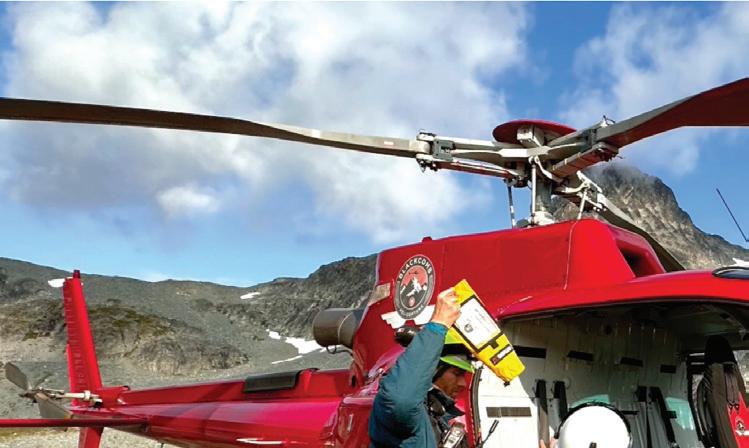
In some cases, “we’re waiting sometimes two or three hours for helicopters, and sometimes we don’t get them at all,” he added.
Moral of the story? Be prepared with extra layers, food, water, a fully-charged communication device, and other survival items before heading out. Visit adventuresmart. ca for a refresher on the “three Ts”—trip planning, training and taking the essentials— before venturing into the backcountry. ■
HIGH RISK Whistler Search and Rescue volunteers extricated an injured climber from a narrow ridge on Mount Weart on July 26.

PHOTOGRAPHER NATALIE WANNAMAKER SAYS WOMAN IGNORED HER WARNINGS OF BEARS IN THE AREA, BRINGING HER ON-LEASH DOG WITHIN INCHES OF A YOUNG BEAR ON THE VALLEY TRAIL
BY BRANDON BARRETTWHEN WHISTLER PHOTOGRAPHER






Natalie Wannamaker warned a dog walker of a black bear in her vicinity on the Valley Trail last week, she said she was met with a simple assurance: Don’t worry, I’m a local.
“This one woman specifically, with a dog, took complete disregard to what I was telling her and starts screaming back at me that she’s a local. I yelled back I was a local, too, and that didn’t matter,” Wannamaker recalled. “She proceeded through the Valley Trail directly by these two juvenile black bears. One bear comes up face to face to the dog, and the dog was barking like crazy. The bear luckily didn’t get aggressive, but you can imagine how it could have gone differently.”
Wannamaker was near Nita Lake Lodge on the Valley Trail last Thursday, Aug. 3 when she spotted the two young bears “doing their typical routine: eating berries, climbing trees.” An independent wildlife photographer, Wannamaker began capturing the animals, letting passersby know of their presence.
“People had taken notice of the bears and they were being cautious as well,” she said. That’s why Wannamaker was so taken aback by the woman’s seeming disregard for the bears—and the safety of her and her dog, for that matter. Calling it a “forced bear encounter,” Wannamaker said the woman dragged her dog, on leash, within inches of the young bear.
“I can’t believe she brought her dog into the situation. Any animal lover would recognize that she not only put herself in danger, but the dog, the bear and everyone in the surrounding area as well,” she said. “It was so irresponsible I can’t even believe she did that.”
Wannamaker said she gave the woman an earful, before reporting the incident to the Conservation Officer Service (COS). The












COS did not return a request for comment by press time.
Wannamaker typically uses a telephoto lens, which allows her to shoot wildlife from a safe distance—unlike the smartphone-toting tourist or curious local eager to get a shot of a bear for their social media.
“Generally, I find locals are OK, but in this circumstance, this woman was [using it as an excuse],” she said. “That’s not something I see usually. I’m sure there are more people with that demeanour—which I want to advocate against. The last thing I want to see in Whistler is someone get mauled by a bear.”
You might be familiar with Wannamaker’s work. Last summer, a video she posted to her TikTok account (@nataliesgeo) of a curious black bear sniffing around a woman at a Whistler bus stop went viral, amassing, at last count, nearly 650,000 views. She said she uses her social media as a way to not only share her work, but the proper etiquette around wildlife, too.
“I share bear safety tips with people on TikTok and people have been super receptive of the work I’ve done online,” Wannamaker added. n























































GENERALLY SPEAKING, municipal reports tend to be drier than sandpaper. Endless pages of sterile facts and figures, paired with the kind of highly technical, legislative language that would put even your high-school civics teacher to sleep. So, when Resort Municipality of Whistler (RMOW) staff take a different approach to their council presentations, it stands out.
That was apparent at the regular meeting of council last Tuesday, Aug. 1, when climate coordinator Maria Thorlakson opened her presentation of the findings from Whistler’s 2022 annual greenhouse gas inventory and climate action progress report with a thought exercise.
“I want all of us to imagine a Whistler where our culture aligns with the vision of a net-zero, climate-resilient, sustainable resort community; a Whistler that is car-free, because we have electric shuttles and zerocarbon rapid transit connecting neighbouring communities; a Whistler where parking lots have been converted into parks; a Whistler where the tourism economy is diversifying
with offerings in eco-tourism; a Whistler that is seen as the most climate-resilient resort town; and a Whistler that has achieved net zero by 2050,” she said.
Taken from the RMOW’s oft-touted Whistler Sessions, Thorlakson is referencing one of four possible futures envisioned in the exercise, specifically Scenario 2, “Weather the Storm,” which “aims to realize Whistler’s vision as a climate-resilient resort that preserves a sense of belonging for its residents.”

At present, the scenario remains in the realm of imagination, but it does speak to a local government eager to find new ways to inspire concrete action in a populace that has grown weary of the same doom-and-gloom messaging it often hears associated with the climate crisis.
Whistler continues to lag behind many of its 2030 climate and GHG emission reduction targets, with 2022 data showing the resort generated 138,859 tonnes of CO2 equivalent, seven-per-cent higher than 2021 and one-per-cent higher than pre-pandemic levels from 2019. Emissions were also four-per-cent higher than 2007 levels; the
RMOW has set a target of cutting emissions by half from 2007 levels by 2030.
“This number indicates that Whistler has returned to pre-pandemic-level emissions,” Thorlakson said. “This means we’re at a turning point where, now more than ever, action is necessary.”
The primary contributors to the uptick last year were passenger vehicles and buildingrelated emissions, which, combined, made up a whopping 88 per cent of Whistler’s carbon output. Vehicle emissions in particular were way up—11 per cent relative to 2021—a sign of Whistler’s post-COVID rebound.
On the e-bike front, the RMOW estimated a quarter of all users on the Valley Trail so far this year are on an e-bike, up from 14 per cent in 2022, although it’s unclear how many are utilizing their e-bikes for recreation, and how many as a mode of active transportation.
Coun. Arthur De Jong believes these kinds of small victories should be recognized.
“The one thing that motivates me the most currently is watching mothers with their young and their groceries on e-bikes—and that bike being a principal vehicle,” he said. “They’re like climate heroes to me. We need to celebrate these small wins to build momentum.”
Gaining momentum on building-related emissions—which rose five per cent in 2022 compared to the prior year—could prove a taller task. Making up 35 per cent of Whistler’s GHG output last year, it is large commercial buildings, such as hotels, that are the largest contributor. Although there are financial incentives available for commercial operators to retrofit their buildings for energy efficiency, there has so far been little take-up locally, the RMOW said. With few policy levers to rely on, municipal staff is planning to sit down with hoteliers and BC Hydro representatives this fall to better understand the issue.
Applauding the vision for climate action municipal staff set out before him, De Jong acknowledged the long, uphill battle it’s going to take to get there.
“I really appreciate the vision, but I’m struggling deeply to put the numbers and the actions into a priority that make the vision real,” he said.
“Whistler needs to step up and lead as it once did. Currently, we are just a reflection of the global failure to fix the climate crisis.”
View the report in full at whistler.ca. A longer version of this story can be found at piquenewsmagazine.com. n




USING BORROWED FUNDS to buy property in Whistler this August—or most places in Canada, for that matter—will cost mortgage holders more than it would have just a couple of months ago.
That’s due to the Bank of Canada’s decision to raise its benchmark interest rate by 25 points in July, pushing interest rates to five per cent for the first time in more than two decades. It marked the central bank’s 10th hike since it started raising key interest rates in March 2022.
As interest rates continue to rise, real estate prices in Whistler appear to be rebounding after dipping slightly over the last year.
A July 2023 report from the Real Estate Board of Greater Vancouver shows the benchmark sale price for a residential property in Whistler sat at $1.426 million last month. That represents a 7.3-per-cent drop year-overyear, but a 9.2-per-cent increase over the last six months—and a 177-per-cent rise over the last decade, more than double the 84-per-cent 10-year change for properties across the entire Lower Mainland.

“We’ve seen from the height of the market in June 2022, the impact of the interest rates right away in those last six months of the year

and the first month of this year,” explained Stefanie Hostetter, CEO of RE/MAX Sea to Sky Real Estate. “It did slow down the market, it did decrease people’s buying power, and then when the Bank of Canada held [its] rates earlier in the year, people either breathed a sigh of relief, or got over it or got used to the idea of interest rates being at this point, and then they stepped back into the market again. This is where we’re seeing our recovery in terms of pricing.”



A benchmark price is calculated using a Housing Price Index to represent the estimated sale price of a typical property within a specific market, excluding outliers like high-end luxury homes and lower-end properties that can skew other metrics.
Whistler’s real estate market isn’t shielded from the impacts of external factors like rising interest rates, but it is difficult to compare to other communities, for a few reasons.
“We’re a second-home market, so people don’t need to make that purchase in Whistler,” Hostetter explained. “They might hold off if the interest rates aren’t in their favour, and that’s where you’ll see a slower market sometimes— and sellers will hold off as well. If they’re not going to get their desired price, they don’t need to sell their second home.”
Still, historically low inventory means multiple-offer scenarios are still a reality when a highly-desirable Whistler property hits the
market. As of Tuesday, Aug. 8, there were 234 properties for sale in Whistler.


“When the market is slow, and we have lots of options, you can have up to 400 to 600 listings,” said David Higgins, managing broker at the Whistler Real Estate Company (WREC).
According to WREC’s market report for the second quarter (Q2) of 2023, the resort tallied 151 total sales throughout April, May and June. The market snapshot lists the median price of a single-family detached home at $2.853 million. Townhouses sold for a median price of $1.523 million in Q2, or $867,000 for condos.
Whistler recorded 236 sales in the first quarter (Q1) of 2022, and 136 sales in Q1 this year.







Those statistics offer a high-level glance at market trends in Whistler, but the metrics don’t paint the full picture, Higgins said.

“It gives you a benchmark of what the market is doing, but it doesn’t actually tell you what you can get for that [specific price],” he explained.
For buyers looking to purchase in Whistler, “The first question is, ‘What do you want?’” Higgins added. “Do you want a piece of dirt or do you want to be able to walk to the ski hill? Are you looking for a cabin or are you looking for a modern home?”
Even with numbers suggesting a downward trend in pricing, Hostetter said

she still wouldn’t classify Whistler as a buyers’ market.
“I would still say that it depends entirely on the property, and what segment you’re in,” she said. “I hate to be vague, but we’re such a small market that each property is different in its own way.”



For now, with no new market housing developments being built in Whistler, Hostetter said she expects prices to continue increasing, “unless the Bank of Canada really surprises us in September with a big interest rate jump.”
Higgins’ top tip for those looking to buy or sell in the resort ahead of the upcoming ski season? Find a Whistler-based realtor who understands its unique market.


“They’ll tell you, ‘OK, this is what it’s going to cost you to buy, or this is what you can likely get in your neighborhood, in your product that you’re looking for,’” he said.
In the first half of 2023, the vast majority of Whistler buyers (79 per cent) were already based in the Sea to Sky corridor or Lower Mainland, according to WREC. Nine per cent of buyers came from other provinces or areas of B.C., while about 12 per cent of buyers are based outside of the country, with most of those international buyers coming from the U.S.
As a resort municipality, Whistler is exempt from the federal foreign buyer ban that went into effect earlier this year. n


 BY BRANDON BARRETT
BY BRANDON BARRETT
AS THE FOUNDER and CEO of Firecircle, Canada’s only digital tourism and hospitality entrepreneurship accelerator program, Deneen Allen has her finger on the pulse of the industry.
Firecircle’s latest project, Transition to Tourism Entrepreneurship (TTE), a fully funded business development and mentorship program, was inspired by the barriers to Indigenous, rural and remote tourism development in Canada, and the need to improve accessibility to resources and mentorship in the sector.
Funded in part by the federal government, and supported by the Indigenous Tourism Association of Canada, the TTE program offers training and mentorship—valued at more than $5,000 a person—to 1,000 aspiring entrepreneurs and established small businesses in the tourism and hospitality fields.
Asked what the biggest obstacle to remote and rural tourism operators is at present, Allen didn’t hesitate.
“Definitely knowledge. The farther north
you get, there is a lack of understanding of the free market and the simple dynamics of supply and demand, and those are foundational to understanding the mechanics of business in any country, in any free-market economy,” she said. “That’s simply from the way most of those economies are operated: a lot of subsidization, not a lot of competition. There’s just a very small population base, so there aren’t a lot of points of reference for a new business operator to look around and emulate something or aspire to do something.”
Other major hurdles Allen finds are not exclusive to tourism and hospitality are financial illiteracy and a lack of proper business planning.
“Even for veteran operators wondering what is going sideways or what could be better, when was the last time they visited their business plan at the 15,000-foot level and took a look at what’s happening in the next five years, and set goals?” she said. “Are they living their best brand story? Are they executing everything at the level they should be in terms of operations and physical design?”
Whistler businessowners still dealing with rebounding, post-pandemic visitation levels and struggling to fill vacant staff positions may not have the time or capacity to plan that
far ahead, a longer trend that goes back even before COVID-19, Allen posited.
“A lot of businesses were struggling before COVID, and then COVID sent them into a tailspin, so there is a strengthening of your business that is worth the time and the effort
of just pausing, even if it’s just 15 minutes a day to learn something new that is going to help you either turn your business around or reposition it for a healthier future,” she said.
The pandemic also afforded many entrepreneurs the time and space to reconsider their business, and many have leaned into two growing trends in the tourism sphere: wellness travel and outdoor recreation.

“Wellness tourism was on a vertical trajectory before COVID, but the number of businesses we’re onboarding right now who are interested in wellness tourism in all its shapes and forms is really incredible,” Allen said. “A lot of our Indigenous entrepreneurs are approaching their tour business from a wellness perspective. Even non-Indigenous entrepreneurs are doing things like forest bathing and forest-to-table spa treatments.”
The booming wellness trend is also shaping how outdoor recreation is offered.


“Outdoor recreation and hospitality is exploding. There are a lot of camping businesses, a lot of glamping businesses, in our program, as well as medicine walks and tours,” added Allen. “The wellness piece is, I think, really at the forefront of almost everything we’re seeing right now.”
Learn more at thefirecircle.ca/programs. n

























































CELINA DALRYMPLE EQUATES fleeing a raging wildfire to driving through hell.
“It was really, really scary. Dark, really hard to breathe,” she says.
Dalrymple, partner Jason Coons and her parents were ordered to evacuate Tuesday, Aug. 1 at 3 p.m. due to the Downton Lake wildfire burning 110 kilometres northwest of Whistler. The group was staying at their respective properties on Gun Lake.

They quickly packed up.
“Right when I left it, the smoke got really thick and it started raining ash,” Coons said. “We had to pack up a lot of stuff into our vehicles and get out of dodge pretty quick.”
The day before, they had a clear view of the wildfire coming down the hill towards the lake.
“You could see flames, a couple hundred feet tall,” he says. “It was really steep terrain so stuff was kind of rolling down the hill and starting new fires.”
On Wednesday morning, Aug. 2, they watched as the fire hit the lake’s edge, burning cabins in the process.
The wildfire came “hard” and “fast,” according to Dalrymple.


“All of a sudden, the wind changed and it just started coming down close to the cabins,” she said.
Dalrymple and Coons were able to relocate her mother to North Vancouver, where the couple live.
Her stepdad is part of the volunteer fire department and has stayed back to help fight the fire.
“We just feel so bad. It’s such an awesome community up there and the people that have their cabins there have had them for generations,” she said. “It’s very heartbreaking.”
In an update on Sunday, Aug. 6, the Squamish-Lillooet Regional District (SLRD) confirmed fires north of Whistler and Pemberton have taken three single-family homes, along with more than a dozen outbuildings.
The SLRD is working closely with the BC Wildfire Service and other agencies in response to what’s now being called the Bendor Range Complex fires, the regional district said.
The complex includes the Downton Lake and Casper Creek wildfires, both of which have spurred evacuation orders and alerts, and which covered 2,476 and 4,586 hectares, respectively, as of Aug. 8.
In its Aug. 6 update, the SLRD confirmed structure loss on nine properties in the Gun Lake area, including two single-family homes (seasonal, recreational properties) and between 12 and 14 outbuildings (boathouse, garage, pier, storage shed, etc.).
The regional district also confirmed one single-family home burned down in the
Highline Road area due to the Casper Creek fire.
The SLRD is hiring a recovery manager to expedite the recovery process for those affected.
“We recognize that this continues to be a highly stressful situation for our residents in this community,” said SLRD board chair, Jen Ford, in the update. “We are heartbroken to know that some structures have been lost, and understand that all of this is taking a tremendous toll on the community.”
The SLRD’s priority has been to conduct the rapid damage assessment work, verify the information and share it with the property owners who are directly impacted, she added.
“We appreciate that many community members have been awaiting information on the extent of the damage. Our priority was to
ensure that we were able to reach the property owners who suffered structure loss as a result of this fire, before releasing information to the public,” she said.
“We appreciate the community’s patience as we work through this process, and understand that there continues to be a great deal of anxiety as the Evacuation Order remains in place. We encourage all residents within Evacuation Order zones, if you have not already done so, to register for Emergency Support Services. And residents where Evacuation Alerts are in place should prepare for the possibility of evacuation.”
Stay up to date with the latest alerts and notices at slrd.bc.ca.

-with files from Braden Dupuis n



















AS I WRITE, I’m in the middle of a drive across Canada. If you’ve followed this column for more than five years, you’ll know it’s something I do on the regular. Having missed out since 2019, I practically leapt at the excuse of a Toronto wedding and a few days canoeing Northern Ontario on the return to pack up my car and head toward the sunrise. This kind of thing is inexplicable to most people I know who’ve made the haul. Why would you want to do that… again?

Ontario is always the wildcard for weather and other delays); then the Sault to Toronto (I try to arrive on a weekend to avoid rush hour). I tend to do the return journey in early fall to catch the colours and might add an extra day. In any event, I have it down to an art—the waypoints to clock, strategic gas stations, food options, places for a swim, motels, camping, whatever’s needed. Plus, the memories accompanying me, which come in two types—historical and personal.
Historical call-backs comprise a way to reconnect to this great, albeit flawed country. The Trans-Canada Highway links
BY LESLIE ANTHONYReasonable question. And I’ll admit that piloting a car for 12 to 16 hours a day isn’t for everyone. Certainly, having a location-free job without regular hours makes such things easier. But like I said, I also genuinely enjoy the drive. It’s space to listen to books I’ve wanted to read, and think about my own book projects—all to a familiar and comforting visual leitmotif. I also prefer driving to the annoyances of flying—now more than ever.
If I’m in a hurry to get East, it’s a fourvery-long-day affair: Whistler to Chestermere, Alta. (Medicine Hat if I’m really hustling); from Alberta to Kenora, Ont., (a loooong day crossing the entire Prairies and losing an hour to boot); then Kenora to Sault Ste. Marie, or as far as you can get (northern
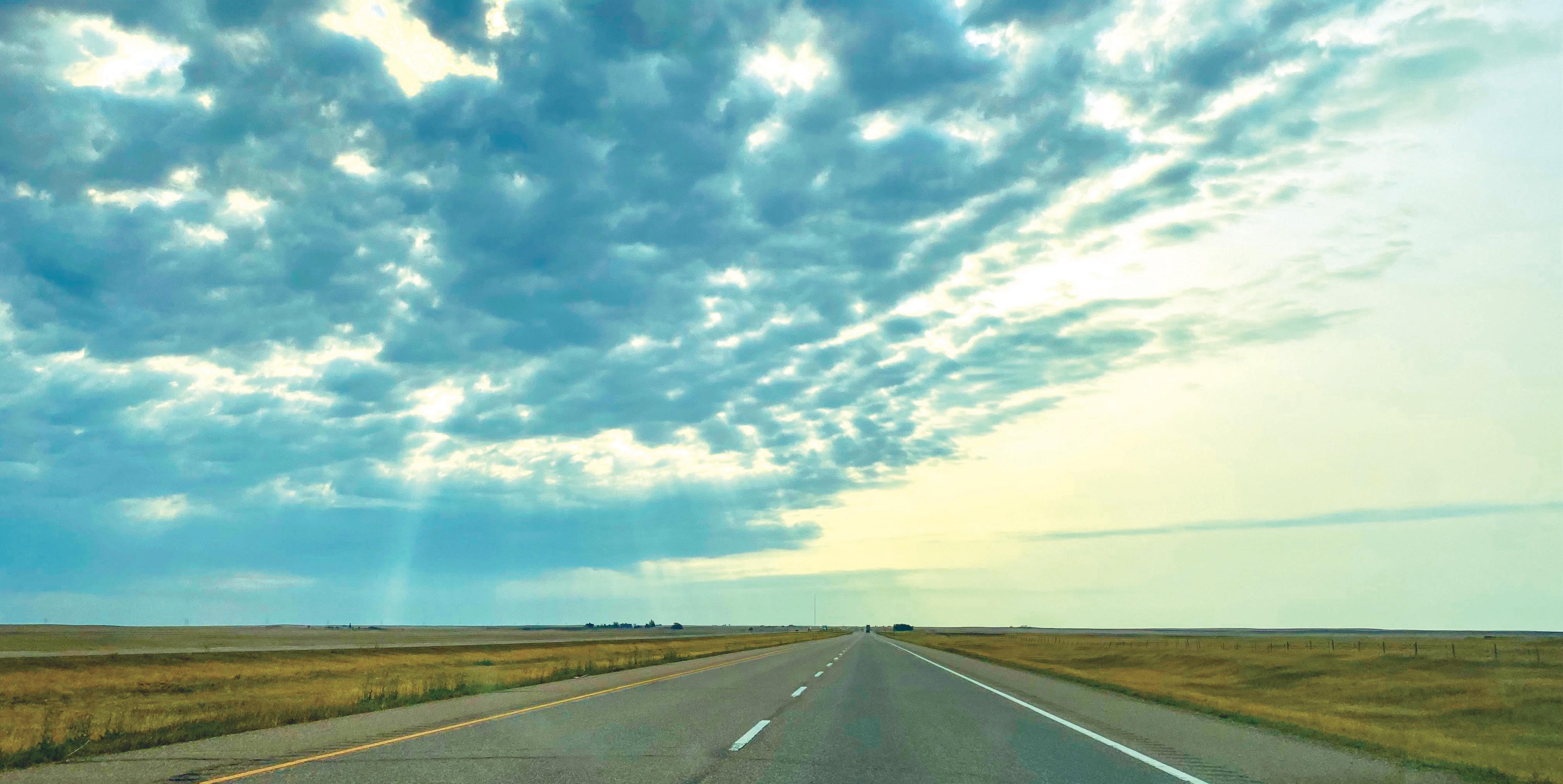
many of the important geographical places and events learned about in school—from Voyageur transit points to the Red River Rebellion, from the end of Terry Fox’s Marathon of Hope to the Last Spike in the critical transcontinental railroad. The mythical landforms and landscapes that filled your mind as a kid also play a part: Rogers Pass, Banff and the Rockies; the Prairies, with their quintessential flat-asa-pancake expanses cut through by river valleys and rolling hills under huge skies; the sudden transition to aspen parkland then boreal forest in eastern Manitoba; northern Ontario’s seemingly interminable wilderness; the Sleeping Giant and red rocks of Thunder Bay; Georgian Bay’s 30,000 islands; and the
skyline of Toronto (…something you’ll get onto/though they say you’ve got to live there for a while, wrote Gordon Lightfoot in his classic, “Alberta Bound”).
Personal memories are equally redolent, but the ones I go back to most are from my first ever cross-country foray as a wide-eyed teenager. The summer between Grade 12 and 13, myself, my brother and a mutual friend took a strange job delivering new cars from Toronto to Alberta for some executive, then driving the trade-ins back. I never understood why this made any sense—or why they’d hire three newly licensed teens—and in hindsight
an hour at certain times of day. Although these pinch points have been scoured for through-driving efficiency, I fondly recall being introduced to each city for the first time and taking its pulse—lured into a “social” in Winnipeg by roadside signs, or spontaneously buying cowboy hats at a Calgary western outfitter. Such serendipity can’t be relived today even without bypasses due to the homogenous mall-and-franchise landscape (“McDonaldization,” so to speak) following the old routes in and out of cities.
I’m sure there must have been some kind of scam underway. Whatever the reason, I learned to love and excel at the long-distance drive, becoming attuned to a country which, to that point, existed for me only in textbooks and National Film Board joints.
In the early 1970s, the Trans-Canada Highway was still a celebration, a concrete bow typing up a generational present, and looked and behaved in kind, delivering the country’s diversity and regional pride like a slow film. Indeed, once you passed Barrie, Ont., you were on an intimate two-lane all the way to Vancouver. In those days, there was no bypass for Winnipeg, Regina or Calgary—you drove straight through, which, given traffic and lights, could easily cost
It’s sadder to see some of the other changes the years have wrought—the lack of animals (those first drives were awash in moose, bear, pronghorns and Prairie dogs rarely seen today), and the abandoned mom-and-pop restaurants and motels of yore, now boarded up, covered in graffiti, burned or all three. In Rossport on legendary Lake Superior, my favourite spot to listen to loons and contemplate the legends of Gitche Gumee, the sloping, glacier-scoured pink granite of the Canadian Shield has been besmirched by painted messages—an inexplicable lack of appreciation for and affront against nature—the worst kind of vandalism and something that makes me feel very old indeed.
Fortunately, some things haven’t changed. I’ll never forget some of those first geographical watersheds—the serrations of the Rockies rising like a mirage on a distant Prairie horizon, or rounding the spectacular Lakehead during sunrise—because they still happen much as they originally did. Letting such visages sink deep into my psyche to settle with kindred moments vanquishes any scintilla of inexplicability about why I love this drive.
This kind of thing is inexplicable to most people I know who’ve made the haul. Why would you want to do that… again?STRAIGHT SHOT Canada’s Prairies, with their quintessential flat-as-a-pancake expanses cut through by river valleys and rolling hills under huge skies.







































 By Gloria Dickie / High Country News
By Gloria Dickie / High Country News
Nathan Keane is an early riser. On most mornings, he’d let the dogs out to run around the yard at around 7:30. Then he’d make a pot of coffee and enjoy a few quiet minutes to himself before the kids woke up and the farmwork began. But his routine changed one early June day in 2020. First, he forgot to put the dogs out. Then, as he waited for the coffee to brew, he glanced out the kitchen window, across the winter wheat. He did a double take. There—no more than 30 feet from the house—was a grizzly bear.
“There was no mistake about it. It had the big natural hump on the shoulder and the broad face,” he said. And, “It was eating a chicken inside our coop.”
Keane had lived on the plains 16 miles north of Loma, Montana, for 14 years. He married into the farm and he and his wife grew wheat, canola, flax and hemp. They kept chickens, but not cows. To the best of Keane’s knowledge, the closest grizzlies lived some 150 miles west in Glacier National Park— certainly not in the wide-open ranchland of north-central Montana. He reasoned that the bear followed the Marias River, which flows east from Glacier County, near the Blackfeet Reservation, and runs along the edge of the Keane farm. “I guess he happened to smell the chickens and came up out of the river bottom,” Keane said.

At the time, Keane’s grizzly sighting was the easternmost in the United States in more than a century. He had heard murmurings around town that the bears were moving closer, “but you just don’t expect one to be in your backyard,” he told me. As the grizzly pulverized his poultry, Keane dialed up the Montana Department of Fish, Wildlife and Parks to report the animal. But before the officer could make it out to his farm to apprehend the grizzly, a neighbour drove by in a loud pickup. The bear took off, and Keane was left to assess the carnage.
When the state’s grizzly bear management specialist for the region investigated the scene, he surmised that the bear was a three-year-old male that had been moving toward the area, traveling about 10 miles every day. The official set a trap next to Keane’s coop, but the bear was never caught.
After the encounter, the state official installed an electric fence around his coop to protect the ruffled survivors. Keane started carrying a pistol with him on his tractor. “I catch myself looking over my shoulder now,” he said. “It makes you think twice about what else is out there.” After the incident made the local news, Keane was criticized by others around town. “One guy said we should have known better to keep chickens, being in bear country and all. Well, we aren’t in bear country. But maybe we’re starting to be now.”
TODAY, KEANE’S RUN-IN would not be newsworthy. Just a year after his sighting, another grizzly was photographed in the Big Snowy Mountains, about 100 miles southeast of the Keane farm. In the Yellowstone and Northern Continental Divide ecosystems, bears that have been isolated from one another for more than 100 years are venturing out of their respective regions, slowly reclaiming old territory.
The grizzly bear, despite what most people think, isn’t a species unto itself. Rather, it’s one of two living subspecies of brown bear found in North America, the other being the Kodiak bear (Ursus arctos middendorffi) in Alaska. Grizzlies (Ursus arctos horribilis) once ranged as far south as central Mexico, where they were known as oso plateado, silvery bears, for their grayish fur. An estimated 50,000 grizzly bears lived in the contiguous United States when the Lewis and Clark Expedition passed through in the early 1800s. But European settlers
trapped and shot these bears until fewer than 1,000 remained. The southern edge of the grizzly’s range eventually contracted from Mexico to the southern border of the Greater Yellowstone Ecosystem.
Grizzlies also disappeared from the Pacific Coast. In California in the mid-1800s, the bears were still so common that a $10 bounty was placed on their heads. Restaurants fried up greasy grizzly steaks and served them for less than a dollar. But by 1922, there were only 37 grizzly populations left in the contiguous U.S., and 31 would vanish within just 50 years. Survivors sought refuge in the remote forests of Montana, Wyoming, Idaho and Washington.
The grizzly’s gains in recent decades are the result of swift human intervention followed by natural expansion. In 1975, all grizzlies living in the Lower 48 of the United States were protected under the Endangered Species Act. The U.S. Fish and Wildlife Service later designated six ecosystems as the focus of recovery efforts: Greater Yellowstone, Northern Continental Divide, Cabinet-Yaak, Bitterroot, Selkirk and the North Cascades.
Through taxes and donations, Americans spent millions of dollars to restore grizzlies—financing recovery planning, private land easements, and educational programs designed to teach people how to live with an animal capable of eating them. Critically, they also funded the relocation of bears. In the 1990s, scientists augmented the Cabinet-Yaak grizzly population in northwestern Montana by transplanting a handful of Canadian bears into the ecosystem. The descendants of those bears are now wandering into the Bitterroot Range, near the MontanaIdaho border, which has been devoid of grizzlies for decades. Biologists had initially planned to move some Canadian bears into the Bitteroots, too. Now they think the grizzlies may repopulate the ecosystem without their help.
Today, grizzlies number just below 2,000 in the Lower 48. Their population has more than doubled in half a century, and, as evidenced by Keane’s encounter, the bears are no longer content to roam within the boundaries we’ve contrived for them. Yellowstone’s grizzlies have tripled their range in recent decades and are now moving north out of the national park. Meanwhile, grizzlies in the Northern Continental Divide recovery zone are heading south. The populations are now only about 50 miles apart, the closest they’ve been in more than a century. Scientists expect that the bears will join up in less than a decade—two islands becoming a continent.
The return of the grizzly bear from near-extinction is one of America’s unlikeliest comeback stories. The bears are among the slowest-reproducing mammals in North America; they require vast tracts of habitat (an adult male grizzly can have a home range of 600 square miles); and they kill people. Bringing back the grizzly required humans to overcome their fear of predators and champion the return of a known man-eater.
And the grizzly remains a fearsome animal. The bear is 800 pounds of muscle and fat, with sharp canines and four-inchlong claws. It’s extremely defensive, always ready to neutralize a perceived threat. A human being is little more than a rag doll in its immense jaws. Though humans have protected the grizzly from extinction, public sentiment toward the subspecies remains divided: Only the wolf inspires more hatred and mistrust. And as grizzlies expand into places they haven’t inhabited in more than a century, they are crossing not only geographical and political boundaries but thresholds of tolerance.
grizzly outside a resort hotel near Jackson, Wyoming, in 2015. Next to the stone facade, a portly man wearing a furry brown onesie was waving at passing cars. The bear costume’s head was perched above his own, and two fangs protruded over his mustachioed face, almost as if the man had been partially consumed by the bear and was now helplessly peering out of its open mouth. In front of his chest, clasped between wooden claws, he held a placard that read: “I’m Worth More Alive Than Dead.”
I approached the bear, notebook in hand.
“I got this costume just for this event,” the man beamed, performing a small twirl. “Grizzlies are my absolute favorite species! I always feel more alive when I’m in grizzly habitat.”
I ENCOUNTERED MY FIRST Yellowstone
Extending a paw, he introduced himself as Jim Laybourn, and said he had shown up on behalf of Wyoming Wildlife Advocates, a non-profit dedicated to conservation in the state. Inside the hotel, dozens of federal, state and tribal representatives were gathering to discuss the possible removal of federal protections from the Yellowstone grizzly population. If the states—Wyoming, Montana and Idaho—regained management authority, they were likely to legalize a trophy hunt.
The debate over Endangered Species Act protections for Yellowstone’s grizzly bears has dragged on for more than a decade. In 2007, when the population numbered more than 500, the U.S. Fish and Wildlife Service declared it recovered
and removed protections. But environmental groups disputed the government’s assessment and took the agency to court, where a judge ruled that Fish and Wildlife had failed to adequately analyze the impact of climate change on whitebark pine, a key food source for Yellowstone’s grizzlies. Average temperatures in the region had increased by more than two degrees Fahrenheit since the 1950s, and the greatest warming was occurring at elevations above 5,000 feet, where whitebark pine grows. (In 2022, the tree was listed as threatened under the Endangered Species Act.)
Federal scientists launched their own investigation into the grizzly’s food sources. They agreed that whitebark’s precipitous decline had caused bears to forage at lower elevations, making run-ins with humans more likely. And reduced cub survival rates, which had begun to slow grizzly population growth in 2002, coincided with the whitebark decline. However, the scientists also found that Yellowstone grizzlies relied more on meat than other populations, and that many bears already lived in areas without much whitebark pine. They proposed that cubs and yearlings were dying not from a lack of whitebark pine but because too many grizzlies were crowded into too limited an area. Federal officials had again recommended the removal of Endangered Species Act protections for the Yellowstone grizzly population. Laybourn, a lifelong Wyoming resident, declared that despite his costume, he was not a “bear-hugger.” He was most concerned about the economic ramifications of a trophy hunt. “Our tourism economy here is based on bears. I work as a guide myself, and I’ve taken hundreds of people to see grizzly bears,” he said. Scientists funneled past us into the building, carrying hefty manila folders. Laybourn held the door open with his toothpick claws, an inadvertent ursine bellhop. “I want to make sure we have a robust population,” he continued. “Whenever we take people out to see the wildlife and geysers, every single person asks me, ‘Are we going to see a bear today?’”
Federal officials had again recommended the removal of Endangered Species Act protections for the Yellowstone grizzly population. Laybourn, a lifelong Wyoming resident, declared that despite his costume, he was not a “bear-hugger.”
He was most concerned about the economic ramifications of a trophy hunt. “Our tourism economy here is based on bears. I work as a guide myself, and I’ve taken hundreds of people to see grizzly bears,” he said. Scientists funneled past us into the building, carrying hefty manila folders. Laybourn held the door open with his toothpick claws, an inadvertent ursine bellhop. “I want to make sure we have a robust population,” he continued. “Whenever we take people out to see the wildlife and geysers, every single person asks me, ‘Are we going to see a bear today?’”
West was a connoisseur of charismatic megafauna, and had bumped off beasts around the world. Oryx in Namibia. Water buffalo in Australia. Musk ox in Canada. Exotic glass-eyed trophies decorated the wood-paneled walls of his office.
“Stalking a grizzly bear is completely different than going after anything else,” West observed as we moved through the halls. “There’s the man-versus-bear thing that comes into play. Yeah, I’ve got a rifle or a bow, I’m holding an advantage of weaponry, but there’s still an element of danger.”
West told me he supported a mix of management approaches to brown bears. He thought there should be places off-limits to hunters, like Brooks Falls in Alaska, where thousands of tourists can watch brown bears fish for salmon from wooden viewing platforms. At the same time, bear hunting is permitted in other parts of the state. “Alaska is the perfect compromise,” he said. I asked West whether he would hunt in the Yellowstone ecosystem given the chance. Without a pause, he replied:
“I’ll buy the first tag.”
IN 2017, following years of highly contentious meetings, the Yellowstone grizzly population lost federal protections for a second time. Then-Department of Interior Secretary Ryan Zinke called the delisting “one of America’s great conservation successes, the culmination of decades of hard work.” Less than
a year later, Wyoming and Idaho announced trophy hunts. The two states held lotteries for a total of 23 tags, each of which would enable the winner to bag a bear.
More than 8,000 people entered the lotteries, each paying a fee of less than $20. A few hunters gleefully anticipated killing the region’s best-known bear, Grizzly 399, who was often photographed ambling along park roads with two or three cubs in tow. World-renowned wildlife photographer Thomas Mangelsen entered the lottery, hoping to spare a bear’s life by winning a tag and then shooting with his camera instead of a gun. Miraculously, Mangelsen won a tag; Steve West did not.
Following the announcement of the grizzly’s second delisting, environmental groups and the Northern Cheyenne tribe sued the government, challenging the decision to remove protections from the isolated Yellowstone grizzly population rather than prioritize reconnecting populations across the West. Another lawsuit, filed by the Crow, Crow Creek Sioux and Standing Rock Sioux tribes and the Piikani Nation alongside other tribal leaders and societies, alleged that the federal government ignored legal requirements to consult with tribes about the decision. Since 2016, more than 100 Indigenous nations have signed the Grizzly Treaty, committing them to the restoration and revitalization of grizzly bear populations throughout North America.
“Our people have been separated from the grizzly since we were forced onto reservations, but we have not forgotten,” then-Crow Creek Sioux Tribe Chairman Brandon Sazue wrote to me. “In our genesis, it was the great grizzly that taught the people the ability for healing and curing practices, so the grizzly is perceived as the first ‘medicine person’ It is no coincidence that the spiritual reawakening of Native people on this continent has coincided with the modest recovery of the grizzly since the 1970s—a recovery that will end with delisting and trophy hunting in a return to the frontier mentality of the 1870s.”
Just before the trophy hunt was scheduled to begin, the judge presiding over the environmental groups’ lawsuit brought down the gavel. He ruled that the federal agency had exceeded its legal authority when it removed protections from the Yellowstone grizzly. The judge wrote in his decision that it would be “simplistic at best and disingenuous at worst” to not take into account the five other populations of grizzlies outside of Yellowstone. With the bears so close to closing the gap, losing protections would be an enormous setback for the subspecies. If the Fish and Wildlife Service was going to succeed in delisting the iconic bears, it would need to rejoin these island populations, creating genetic linkages that would ensure long-term survival. The trophy hunt was canceled, and protections were restored.
The ruling was a victory for the environmental groups and tribes who had fought hard to keep the animal protected indefinitely. For others living in close proximity to America’s growing grizzly population, it was anything but.
BLACK BART is the only bear Trina Jo Bradley doesn’t mind having around. The enormous jet-black grizzly, pushing 900 pounds, has lived on her ranch on Birch Creek for close to six years. He’s well-behaved, Bradley said, and keeps his brethren out: “Normally, we get bears coming through here pretty thick in March, heading out from the mountains down to the prairie. Since he’s been here, we’ve seen way fewer bears.”
Ranching is in Bradley’s blood. She was raised on a cattle operation some 16 miles south, near Dupuyer Creek in Montana. Her father was a hired rancher, which meant that Bradley and her brothers were put to work at a young age. They rode horses and herded cows. Any free time was spent mucking around outside—but always within shouting distance of the house, and with a guard dog. There were bears near Dupuyer, she said, even back then, in the 1980s and 1990s. Glacier National Park wasn’t too far away, and occasionally a grizzly from the Northern Continental Divide population would wander out and kill one of their cows.
Bradley went south to Casper, Wyoming, for college, where she studied agribusiness. At 22, a car accident forced her to return home to Montana, where, while recuperating, she met her husband. Instead of going back to school like she’d planned, she moved onto his family ranch, where she’s raised three daughters along with Angus cattle and quarter horses.
When her father-in-law bought the Birch Creek land back in 1956, there were very few grizzlies in the area, she said. The first livestock loss happened in the 1990s when a bear killed a calf. Authorities promptly trapped and removed it. “That was the last bear they saw until I moved here. I’m pretty sure the bears followed me from Dupuyer,” she said.
As Montana’s bears grow in numbers and expand their range, they are spending more time on private land, leading to more encounters with humans and domestic animals. In 2019, for example, the state made more payments—$261,000—to ranchers for livestock killed by predators than in any previous year, with nearly twice as many animals suspected to have been killed by grizzlies than wolves. In 2021, when ranchers reported 78 kills by wolves and 119 by grizzlies, payouts topped $340,000.
Bradley’s sage-green farmhouse is surrounded by some 3,500 acres of hayfield and private pasture, where she and her husband run about 250 cows. The house’s living-room window looks out over rolling hayfields, toward the snowcapped perimeter of the Rocky Mountains. From this vantage point, Bradley often watches the bears go by. “Grizzly bears are super cool, and I love seeing them,” she said. “But I don’t love seeing them in my yard or in my cows.”
Though grizzlies are around nearly every month of the year, her ranch hasn’t lost many of its domesticated animals to bears. Perhaps she has Black Bart to thank, or perhaps, she said, “our cows are just mean.” A neighbor less than a mile away, she said, loses between 15 and 20 calves to bears annually.
A few years ago, Bradley was appointed to Montana’s Grizzly Bear Advisory Council, a state-run initiative with the aim of “listening to Montanans” and “following their interests while also conserving bears.” She was passionate about protecting agriculture, and wanted to ensure that farmers and ranchers got the assistance they needed to cope with the grizzlies in their midst. “Pretty much everybody here is just tired. We’re tired of grizzly bears. We’re tired of conflicts. We’re tired of not letting our kids play outside. We’re tired of having to sacrifice our paychecks for the public’s wildlife.” This was one of the most common arguments I
entire state then—that was enough.”
Many ranchers want tougher punishments for encroaching bears. They want them removed from the population right away, not given multiple chances to redeem themselves after attacking livestock. They want more funding for conflict prevention measures. (In 2021 and 2022, Fish and Wildlife provided a total of $40,000 for grizzly-deterrent fencing, with the state chipping in $5,000.) Bradley had set up an electric fence around the chickens and goats in the yard, but it wasn’t feasible to put an electric fence around the entire ranch. For now, she’d have to rely on Black Bart to scare off the others.
“He’s the best guard bear there is.”
CHRIS SERVHEEN first laid eyes on a grizzly in the Scapegoat Wilderness, near Helena, Montana. He was in his early 20s, backpacking with college friends, when they entered a meadow and caught sight of a bear tearing up a huge stump, looking for insects. “We stayed there for a while, just watching him from the trees,” he said. “Grizzlies have this ability to burn into your memory so that you remember everything that was happening when you saw them. It’s really amazing how much you can remember, even years later. That’s the magic of grizzly bears.”
Servheen is arguably the foremost grizzly expert in the United States, having served as the Fish and Wildlife Service national grizzly bear recovery coordinator for 35 years until his retirement in 2016. He was the guy in charge of making sure bears didn’t disappear from the Lower 48, and evidently, he did a decent job of it.
Servheen grew up on the East Coast, but, inspired by the National Geographic wildlife specials that captivated him as a child, he moved to Montana to study wildlife biology. He began by researching eagles under the mentorship of famed biologist and conservationist John Craighead. Servheen pivoted to grizzly bears for his Ph.D., three years after the subspecies landed on the endangered species list. After finishing his doctorate in 1981, he accepted the newly created position of grizzly
regained protections. But his document came back with such safeguards removed. This, he felt, eroded the credibility of the recovery program and made delisting “biologically incredible and legally indefensible.” Knowing it would be up to him to defend such a plan in the face of a lawsuit—which was all but guaranteed—“I quit.”
It wasn’t the triumphant ending to his career that Servheen had imagined. “The grizzly bear recovery program is one of the most successful stories in the Endangered Species Act. They’re a challenging species to recover, and we did it,” he told me, “but all the political bullshit that happened right at the end kind of spoiled it.” Now, rather than spending his retirement fishing, Servheen had made it his mission to bring attention to the risks confronting grizzlies. I asked him if he thought grizzlies should still lose federal protections.
The answer was a decisive no. “For years, I was an advocate for delisting,” he said. He believed that the agency had gotten Yellowstone’s bears to the point where protections were no longer needed. And he hoped states would take on this responsibility with maturity and grace. But lately, “the actions of Montana’s Legislature have proven that the states are no longer able to be trusted when it comes to managing large carnivores.” Servheen pointed to a disconcerting trend in the West that he dubbed “anti-predator hysteria.” The Montana Legislature, for example, had approved a spring hound hunting season for the state’s black bears—a practice that had been banned in Montana for a century. Servheen perceived this as the state sliding backwards into a Manifest Destiny mindset. “It’s really horrifying to me to see this. If they weren’t still (federally) protected, one can only imagine what Montana would do to grizzlies.”
I asked Servheen how many grizzlies he thought the United States could feasibly handle. Some conservation advocates believed we could happily live with as many as 6,000, and lobbied for the bears to be returned to California, the Grand Canyon and the Southern Rockies. Then there were people like Trina Jo Bradley, who wanted far fewer bears than there were now. Most people weren’t willing to give a numerical answer, focusing instead on the genetic health and connectivity of the populations. However, Servheen—the scientist—was ready with an answer: 3,000 to 3,400 grizzlies, at least 1,000 more than estimated to now be living in the Lower 48.
heard from livestock producers: Liberal urbanites want predators back on the landscape, but they aren’t suffering the consequences of a grizzly in the backyard. “It’s not like camping or backpacking,” Bradley said. “We don’t have a choice. We have to go outside. We have to take care of our cows. And there’s probably going to be a bear there.”
As long as grizzlies remain under the wing of the Endangered Species Act, state wildlife managers are unable to relocate or euthanize bears that kill livestock without first consulting the federal government. Ranchers believe this limits their ability to get rid of the bears causing problems. (Environmental groups and scientists have long questioned whether grizzlies are responsible for as many livestock deaths as states allege.) State and federal officials have discussed removing protections from the Northern Continental Divide bears, but perhaps chastened by the Yellowstone debacle, the Fish and Wildlife Service recommended in 2021 that all grizzlies in the Lower 48 remain listed as threatened under the Endangered Species Act.
Bradley disagreed with this assessment. “Grizzly bears no longer need to be protected. They’re not unicorns,” she said.
“How many bears do you think is enough, in an ideal world?” I asked.
“I think when the grizzly bears were put on the Endangered Species Act—there were only like (300 to) 400 bears in the
bear recovery coordinator, but he wasn’t optimistic about the bear’s prospects: There were only about 30 breeding females left in the Yellowstone population. “It’s important to recognize we were really close to losing grizzly bears at that point,” he said.
For more than three decades, Servheen was a constant presence at bear meetings. Whether in Yellowstone, the North Cascades or the Cabinet-Yaak, his nearly bald head stood out among the Stetsons. In 2015, still working at the agency, he maintained that the Yellowstone population, and possibly even the Northern Continental Divide population, should be delisted. The grizzly group had met its ecological recovery goals, and, provided the population was managed carefully after delisting, the bears were guaranteed to be around for a long time.
“The objective of the Endangered Species Act is to get a species to the point where protection is no longer required,” Servheen told me at the time. “The purpose is to fix the problem.” In the case of the Yellowstone grizzly, he believed it had been.
During Servheen’s final years as the grizzly recovery coordinator, he began to worry that the federal government was bending to the will of the states rather than serving the grizzly’s best interests. As the agency prepared for the second delisting, Servheen had written some guidance on how best to manage grizzly deaths once the population lost protections, essentially putting safeguards in place that would stem any future population decline. If too many bears died, for example, these measures would ensure that the population
The Yellowstone ecosystem and Northern Continental Divide, he explained, could support 2,000. The Bitterroot could hold 300 to 400. The Selkirks and Cabinet-Yaak could take another 150 bears. And the North Cascades could support up to 400 bears—though there were none present at the moment. But Servheen warned that, amid anti-predator sentiment, we could begin to see an overall population decline, not an increase. “Grizzly bears are special animals,” Servheen said. “They have low resilience. They live in special, remote places. And if we’re going to maintain grizzly bears, we have to behave and treat them in a special way.”
In February 2023, the U.S. Fish and Wildlife Service announced it would again review whether to remove federal protections from the grizzly bears in both Greater Yellowstone and the Northern Continental Divide ecosystems. Whether or not grizzlies continue to grow their numbers in the Lower 48—and, eventually, close the gaps that exist between populations—depends now on our behavior and our politics. This story was original published in High Country News on July 10, and is reprinted here with permission.
Excerpted from Eight Bears: Mythic Past and Imperiled Future, by Gloria Dickie.
Copyright © 2023 by Gloria Dickie. Used with permission of the publisher, W.W. Norton & Company, Inc. All rights reserved. n




RACE DIRECTOR KRISTIAN MANIETTA SAYS THE NEW DATES ALLOW FOR WARMER WATER AND REDUCED ENVIRONMENTAL IMPACT
BY DAVID SONGHEADS UP, Sea to Sky triathlon enthusiasts: XTerra Whistler is getting a bit of a facelift.
Unlike last year, the popular off-road contest will take place on Sept. 16 and 17 as a two-day affair. According to race director Kristian Manietta, the change in date was prompted by environmental and logistical factors.
Having the triathlon in June, as was the case in 2022, forces athletes to deal with frigid water as they make their swim through Lost Lake, as well as soggy grass prone to being damaged by foot traffic. Moving the event to September is meant to address both issues, as well as leave the annual western toad migration undisturbed.
Meanwhile, the shift to two days allows Manietta and his team to spread out their three races. The sprint distance and kids’ event is currently scheduled for Saturday the 16th, leaving the championship distance for Sunday the 17th.
“That allows less congestion on the bike course,” Manietta explained. “It’s very challenging to have a bike course at Lost Lake that doesn’t cross over [itself], so having the distances on separate days will make it a little bit more enjoyable for those that have to do two laps on the bike [so they won’t have] to potentially pass people.”
Otherwise, XTerra Whistler remains largely the same event that has attracted athletes
of varying skill levels from all sorts of backgrounds. Those wanting to ease themselves in, relatively speaking, can attempt the sprint, which consists of 750 metres in the water, 11.6 kilometres on the bike and five km on foot.
More seasoned triathletes, or those in need of a challenge, usually prefer the full championship course: a 1.5-km swim, 23.2km bike ride and 10-km run. For reference, the Olympic triathlon has a longer second stage: 40 km on two wheels.
Of course, XTerra contestants ride their
Last year, a bevy of youngsters embraced the race despite chilly waters in the 14 C range.
“They had an absolute ball,” he remembers. “Most kids in the Sea to Sky have a bike, so they could [ride it], they could either swim or go across the shoreline depending on what they felt was fine. We had a couple of different bike courses and running courses.
“They got a full taste of a mini-XTerra and they absolutely loved it. The parents loved it, too.”
“It was really great to get them involved,
that, opening the door for Manietta to twist his wife’s arm into accepting a leadership role.
“I was a little bit reluctant to start with, but I found that I do really love being involved just because it is so rewarding when people have such a good time,” Paul said. “You see people challenging themselves— they’re looking at the finish line when they’re exhausted, but they’re proud of themselves.
“I know what that feeling is like as an athlete myself, so I get huge satisfaction from seeing other people feel that, too.”
Both Manietta and Paul are lifelong athletes passionate about creating worthy recreational experiences for others. They also help facilitate the Run Comfy Numb and XTerra Pemberton trail races, with Manietta directing both. Yet for him and his wife, there’s something special about the triathlon: that distinctive multidisciplinary endeavour that offers something for both the serious endurance athlete and the weekend bike park warrior wanting to branch out.
mountain bikes through rocky and root-filled trails as opposed to Olympians who hit paved roads. It’s an excellent fit for the generally mountain bike-crazy denizens of the Sea to Sky.
Youth will again have their own time to shine. Six- to eight-year-old registrants will do a 25-m splash through Lost Lake, two km on their bikes and a one-km run. Those in the nine-to-15 age bracket instead face a 50- or 100-m swim depending on ability, a four-km ride and a two-km footrace.

Manietta considers introducing a kids’ event to be “one of the best things [XTerra] did,” and rave reviews from most grown-ups he’s heard from would support that claim.
so they could feel a part of things,” added Manietta’s wife, Charlotte Paul. “[It’s not always fun] for kids to get dragged along to their parents’ events, but to be able to do it themselves was really cool.”
September will mark the fourth time XTerra has brought a triathlon to Whistler. Originally the brainchild of a group of Whistler Triathlon Club board members, including Manietta and original race director Dale Tiessen, the race first occurred in 2019 and returned in 2021 as a relatively small, last-minute event. Tiessen stepped away from directing after
After all, there’s a reason Manietta calls the XTerra Whistler sprint race a “gateway drug.” It’s an authentic taste of the triathlon world that pushes you, yet won’t demand six months of your life the way preparing for an Ironman would (that’s roughly four km in the water, just over 180 km on two wheels, and a full 42.2-km marathon to wrap up).
“It is a kind of strange feeling to get off the bike after you’ve been pushing hard and then expect your legs to run,” Paul said. “It’s a challenge, but it’s within reach.”
“We wanted to bring the good stuff to Whistler in this event,” added Manietta. “We all need some challenges, and when you see people overcome some of those challenges … and [reap] the rewards from having come across the finish line, it makes it all worth it.”
For more information, visit xterrawhistler.com. n
(OFF)ROAD RUNNERS The 2023 XTerra Whistler off-road triathlon will take place on Sept. 16 and 17. PHOTO BY GUY FATTAL“[It’s not always fun] for kids to get dragged along to their parents’ events, but to be able to do it themselves was really cool.”
- CHARLOTTE PAUL















NICOLE DRAKE’S EXCITEMENT is palpable.
Ever since she was tapped to be the head chef for Alta Bistro’s café spinoff, she’s been eagerly asking friends, family and anyone else with tastebuds for their menu ideas.
“Someone told me they’re missing a good Nicoise salad in town, so, boom, I’m putting a Nicoise salad on the menu. Another friend went to the city and she had a matcha croissant and said we need to do that, so we are,” said Drake. “That’s the whole point of cooking, isn’t it? I make myself happy, but it’s for other people, too. I love making people happy.”
Drake will have plenty of opportunity to spread the joy at Alpha Café, a concept a couple years in the making for Eric Griffith and the rest of the team at the award-winning Alta Bistro.
“It’s a little offshoot of Alta. Everything is getting produced in the kitchen at Alta and we’ve got plans for service on the café side,” said Griffith, owner and wine director. “We’re looking to have a cool, casual place that people can come in the morning or midday for breakfast and lunch.”
Located just one door down from Alta Bistro in the Pinnacle Hotel Whistler Village, Alpha Café will not only share a kitchen space with its parent restaurant, but its penchant for inventive, seasonal cuisine made from the finest hyperlocal ingredients.
A former sous chef for Alta Bistro who left in 2021 to work for Whistler’s Rising Knead Bakery, Drake said the restaurant’s commitment to sustainability and forging close ties to local producers are the two biggest elements she wants to incorporate into the new café.

“We’ve built such a good relationship with the farms up in Pemberton and everyone is so excited for this to happen that they want
to throw their products at us and see what we can do with them. We have so many different suppliers that anyone can just bring whatever they’re most proud of,” she explained. “I barely have to go in search for anything. People come to us.”
Drake said she was inspired by the coffee culture in her native Australia when conceptualizing the café.
“There are so many cafés in Melbourne that I’ve always loved going to. I miss those
takeout treats, those pocket things you can take and eat right away,” she said. “I see it as this sit-down café where you can come in and have that familiarity with the staff. I feel like sometimes, there’s just such a massive lineup to go to places on the stroll, so I like that we’re off the Stroll and you have to know where to find us.”
The menu will skew towards standard breakfast fare—think sandwiches, breakky bowls, quiche and other gourmet pastries—
elevated to the standard Alta Bistro is known for, along with some unique items emerging directly out of Drake’s mad-scientist brain. Like, for example, what Drake is calling the “tasty-mite cheese scroll,” her take on a classic Aussie pastry that features that uniquely Down Under spread, vegemite.
“I’ve started making my own version of vegemite; I found a recipe online from this guy who used to make it for his restaurant because he had so many Aussies coming in,” she said. “It’s just this crazy, umami, cheesy, buttery pastry. It’s going to change your life. It’s also for the people who say they don’t like vegemite.”
The coffee, meanwhile, will come from Alta Bistro’s longtime supplier, Vancouver’s Milano Coffee Roasters, and will focus on espresso-based drinks.
“It’s not like a coffee shop with food as a sidebar,” Griffith noted. “It’s going to be foodfocused—with coffee as a focus, too.”
The décor hews to Alta Bistro’s usual local emphasis, with a sleek, contemporary look that plays off of Whistler’s alpine setting.
“We used a lot of local materials, and we used all local craftsmen to do it,” Griffith said. “The initial vibe, what we were going for was modern mountain, or mountain chic, capturing the colour tones of what we have here in the forest, in the rock—the types of colours you see on a mountain.”
Planned to open from 7:30 a.m. to 3 p.m. daily, Griffith said ideally the café would eventually extend its hours into the evening. More than anything, Griffith is hopeful Alpha Café serves as a go-to spot to catch up with a friend or host a meeting.
“We’ve managed to get a number of seats inside, so it will be quite a comfortable place to come sit and meet someone, versus a coffee shop where you may have limited seating,” he said. “That’s what I was envisioning: a place people can rely on to get a seat.”
Griffith is hopeful the café will be ready to open by the end of the month. n



OPEN DAILY: 6 a.m. to 9 p.m.
ARENA SCHEDULE
Please see whistler.ca/recreation for the daily arena hours or call 604-935- PLAY (7529)





OVER ITS 12 YEARS, THE GRASSROOTS EVENT HAS BLOSSOMED INTO A SHOWCASE FOR LOCAL AND REGIONAL PERFORMERS ALIKE
BY BRANDON BARRETTAS A RULE, Whistlerites love proving how local they are, and there is perhaps no better litmus test than asking someone if they know what The Point Artist-Run Centre is, or, for that matter, its flagship annual event, the Flag Stop Theatre & Arts Festival.
Part of The Point’s hidden-gem status is due to its literal off-the-beaten-path locale, a heritage fishing lodge turned grassroots arts hub nestled on the shores of Alta Lake, only accessible by car through West Side Road and no longer serviced by transit. As someone who has performed at The Point and its beloved celebration of live original theatre, music and comedy for more than a decade (this week marks my 11th Flag Stop in a row!), I had assumed the event’s relatively low profile on the resort calendar was at least partly by design. After all, in a tourism town that evolves at breakneck speed, us Whistlerites tend to be overly protective of any local secret.
Not so, according to The Point’s artistic director Stephen Vogler.
“The festival, I’m not trying to keep it small and hidden,” he says with a laugh. “I want it to become known and a draw beyond Whistler. That’s always been the vision: to get it on the map to the point where people from the Lower Mainland, elsewhere in the province and beyond might want to come out to a destination-type event. We’ve got a ways to go on that, but that’s the idea.”
Inspired by the folk festivals and art fairs he attended on Vancouver Island, Vogler is moving closer every year to his original vision for Flag Stop: a showcase for both B.C. performers and Whistler’s criminally underrated arts scene, in a venue like no other.
“The vision I started with was original theatre on the floating stage, live music, and art. I’d say that has carried through. It’s just that it’s grown larger,” Vogler says.
Much larger. What began in 2012 as a one-night affair, with just a single band and Vogler’s own short play on the bill, has grown into two nights of live entertainment at The Point, Aug. 11 and 12, featuring a packed lineup of both local and regional performers. That’s on top of satellite events in the village, on Aug. 8 and 9, when organizers exported Flag Stop to Florence Petersen Park for two nights of live music, kids’ programming, food trucks, and
live comedy by Laugh Out LIVE!.
The added events are one way Vogler can expose Flag Stop, and by extension The Point, to a wider audience.
“I do like reaching out to the village because that’s the centre of town, so you can get to a broader and larger number of people,” he says. “It’s beautiful forest on one side, the library and [Whistler] Museum on the other. It also slopes like a natural amphitheatre.”
But The Point and its unique floating stage remain the festival’s centrepiece. And if you need further proof of the event’s drawing power, just count how many former Whistler locals are returning to take part. You’ve got born-and-raised Whistlerite Sarah Ford coming all the way from the Big Apple to kick things off on Friday, Aug. 11 with a stand-up comedy set. Later that night, former local Emily Molloy is bringing her badass country band, Pistol Whip the Devil, which is making waves in the Vancouver scene after forming during the pandemic. Then, slated for Friday and Saturday nights, you’ve also got local playwright Karen McLeod’s stirring production set in the Sylvia Hotel, Yours Truly, Kay, hitting the stage, directed by a name that looms large over the resort’s performing arts scene: Angie Nolan, who left Whistler in 2020 to pursue her TV and film ambitions in Vancouver.
“I can check out anytime, but I can never leave,” Nolan says of Whistler. “I feel like having been so heavily involved in the arts for so long, pretty much two decades, and then having moved away during COVID times, it’s a big hole to fill. There are things that have opened up for me in Vancouver in that way, but nothing as deeply rooted. I just hold The Point so dear to my heart.”
The other play on tap for both Friday and Saturday nights at The Point is North Vancouver playwright John McGie’s Bloppera, a fast-paced farce inspired by the melodrama of daytime soap operas.

That will be followed, on Saturday night, with the stylings of Garret T. Willie, an Indigenous guitar prodigy hailing from B.C.’s Kingcome Inlet.
“He’s a guitar phenomenon. He’s really doing well, so it’s pretty exciting to have someone like him in the lineup,” Vogler says. “The local scene and the broader Western Canadian scene cross over a lot more than they used to.”
Tickets to either remaining night of the festival are $55 with dinner included, or $30 for the show only. Dinner tickets must be purchased in advance, at thepointartists.com. Show-only tickets can be bought online or at the door. The festivities kick off both evenings at 6 p.m. n
IN 2016, we wrote an article on Jim McConkey, where we mentioned him bringing in his collection of 16-millimetre ski films. At the time, we were unfortunately not able to view them, as we did not have the necessary equipment. Well, it has been a long time since 2016, and in that time we were able to acquire the right equipment for digitizing 16-mm film thanks to the support of the Whistler Blackcomb Foundation. We have since digitized McConkey’s collection, finding some very interesting videos.
“Diamond” Jim McConkey was an accomplished ski instructor for many years before he came up to Whistler. Born in Barrie, Ont. in 1926, he quickly fell in love with skiing and moved out west in 1948 to ski the bigger mountains in the Rockies. He worked as the first ski-school director in Park City, Utah, and eventually moved to Tod Mountain to run the ski and rental shop at the mountain. In 1968, he was invited to open his own ski and rental shop in Whistler, as well as running the ski school. He ran the ski school until 1980, and the ski and rental shop until 1985. McConkey also ran a heliski operation, through Okanagan Helicopters, where he could take clients skiing in the glaciers around Whistler Mountain.
Throughout his career, McConkey made lots of ski films in places all over North America, with accomplished filmmakers such as Warren Miller and Douglas Sinclair. In 2016, he stopped by the museum and brought with him his collection of old 16-mm films, which we were then unable to view. However, the museum recently acquired the RetroScan, a piece of equipment that allows us to scan these 16-mm films into a 4K video format, and, using some other software as well, we were able to get both the video and the audio off these 16-mm films, and finally take a look at them.

McConkey collected a wide variety of ski films over the years, and has films from all over the world. As of right now, we have 12
films digitized from his personal collection. One such film is Marker Ski, which consists of footage of the 1977-78 FIS Alpine Ski World Cup that took place in Austria and Germany, specifically at ski resorts such as Garmisch and Kitzbühel, and includes some of the skiing greats, such as Ingemar Stenmark, Phil Mahre, Klaus Heidegger, and Franz Klammer. Other films in his collection range from a Japanese ski team skiing Nunavut’s Barbeau Peak, the largest mountain in eastern North America, in a film called Brilliance of Fantasy, to instructional ski films such as Ski the Outer Limits, Invitation to Skiing, and Ski Total. He, of course, also left us with some ski films that he starred in throughout his career.
McConkey personally starred in quite a few ski films, but the ones we have digitized are Alpine Ski Technique, Ski Nanny, and Snows of Garibaldi Alpine Ski Technique is an instructional ski video filmed at SaintJovite and Whistler, where McConkey is the high-mountain, expert ski instructor and gives tips on jumping on skis, as well as showing off some great skiing accessed by helicopter.
Earlier in his career, when McConkey was still at Tod Mountain, he starred in an episode of journalist Bob Cram’s television show, Ski Nanny, where the pair go skiing in some deep powder. And finally, we have Snows of Garibaldi , a Sinclair film which, according to McConkey in a 2022 oral history conducted by the museum, was one of his favourite films to make. In this film, McConkey goes heli-skiing with one of his instructors, Guy Barvoets, and it isn’t hard to imagine why this was one of his favourites—the high-mountain skiing looks incredible, and the aerial shots of McConkey and Barvoets skiing untouched glaciers are breathtaking. McConkey is and always will be one of Whistler’s greatest icons, and the footage we’ve seen so far certainly backs this statement up.
SEPTEMBER 2.2022
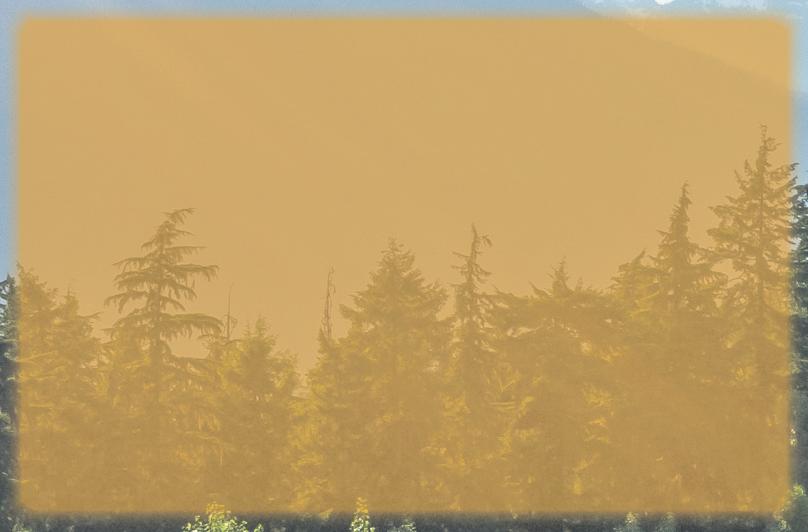
$220*
Wine And Dine Under The Setting Sun
5:30 PM - 9:00 PM
3-COURSE
Savour the flavour s of summer over an enchanting evening of food and wine pairings fromCloudy Bay Wines and Fair mont Chateau Whistler


LEARN MORE & RESERVE > * per per son plus taxes and fees







Here’s a quick look at some events happening in Whistler this week and beyond. FIND MORE LOCAL EVENT LISTINGS (and submit your own for free!) at piquenewsmagazine.com/local-events
Stop by Creekside Village on Saturday, Aug 12 from 11 a.m. to 5 p.m. to shop locally-made wellness products, food, clothing, soap, home decor, candles, jewelry and more! See the village come alive and explore—or just hang out and take in the lively atmosphere.



> Aug. 12, 11 a.m. to 5 p.m.





> Creekside Village
> Free





Join us for a live and local music series every Sunday until Sept. 3 in Rebagliati Park. Immerse yourself in diverse genres, connect with fellow music lovers, and let the melodies transport you to a world of sonic delight. Don’t miss this vibrant community experience where live music meets the beauty of nature. These concerts are free and everyone is welcome. Catch Pemberton’s Dakota Pearl on Aug. 13.
> Every Sunday until Sept. 3, 1 to 3 p.m.

> Rebagliati Park
> Free

Make Movies in the Plaza your new summer tradition and get cosy on the Great Lawn for a cinematic experience under the stars. Movies are scheduled on select Wednesday and Saturday evenings this summer and are free to watch. There is a free bike valet available on site. On Aug. 12, catch the Kevin Bacon classic, Footloose. On Aug. 16, see the 2001 Ben Stiller hit, Zoolander.
> Aug 12 & 16, 8 p.m.



> Whistler Olympic Plaza



> Free














MAC’s Making Connections is a weekly program for people with early-stage dementia and their caregivers on Wednesday mornings. More like a social club, this program starts with 45 minutes of gentle fitness, followed by games and brain-stimulating activities, and socializing over a light lunch. The goal is to slow cognitive decline in the afflicted and allow caregivers to bond, share experiences and develop their own support network. Register at whistlermac.org under the events tab, Making Connections Program. Prepay by e-transfer to treasurer@whistlermac.org.
> Aug. 16, 10:30 a.m. - 1 p.m.
> Our Lady of the Mountains Catholic Church
> $5

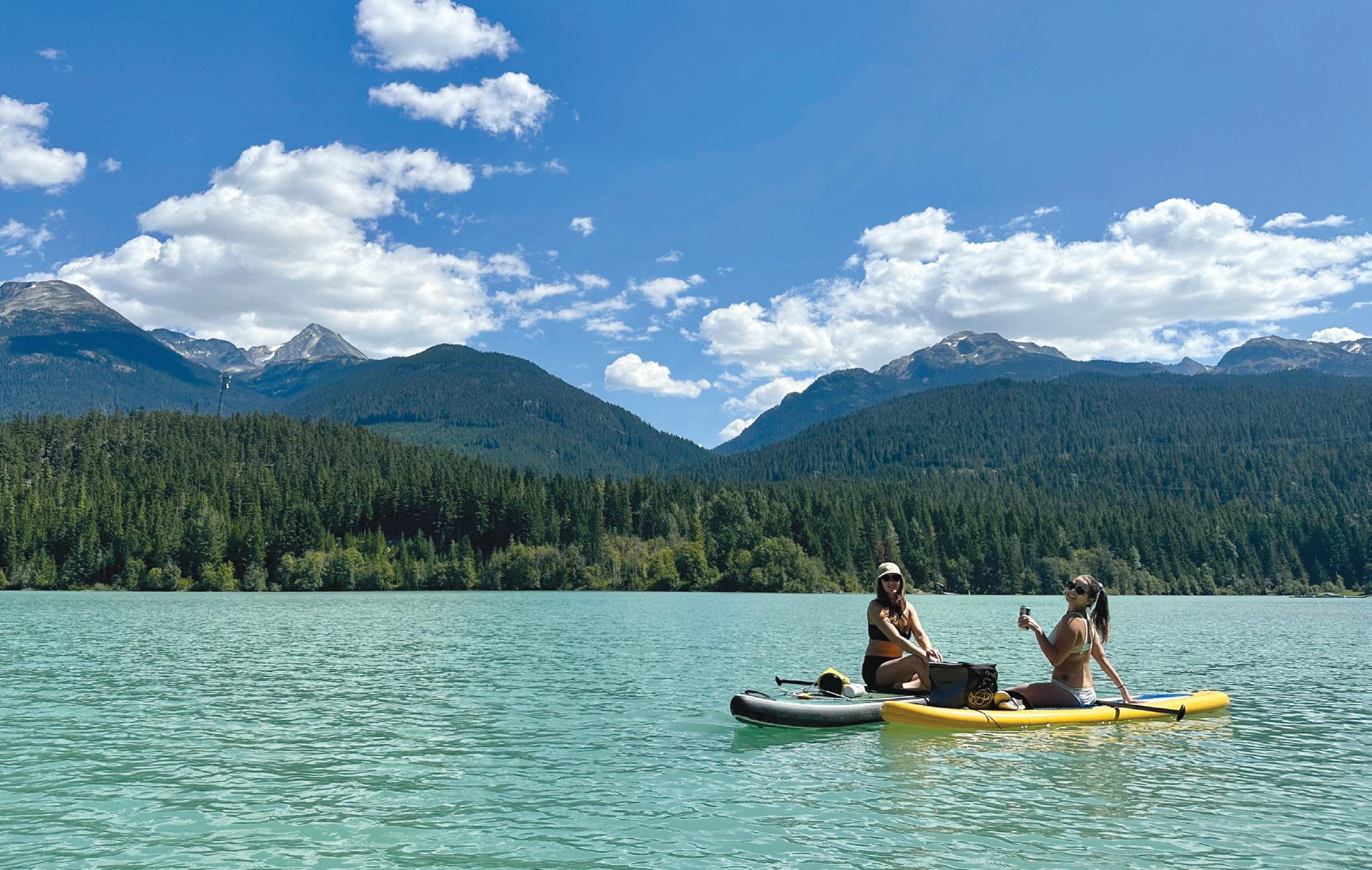












We invite you to join us on August 17th to discover the proposed plans for our development, located on the corner of Prospect and Aster street, downtown Pemberton.
WHEN: AUGUST 17TH, 2023
WHERE: THE PEMBERTON COMMUNITY CENTRE 7390 COTTONWOOD ST
TIME: 5-7PM
If you can’t make the information session, send us an email We want to hear your thoughts!
admin@fitzgeraldinc ca


WEEK OF AUGUST 11 BY ROB BREZSNY

ARIES (March 21-April 19) In Stephen King’s novel It, a character named Beverly is in love with a man who projects a sense of authority but also listens well. He is strong-minded but receptive; confident but willing to be changed; self-possessed but open to influence. That’s an apt description of the allies I wish for you to attract into your life in the coming months. Whether they are lovers or partners, companions or collaborators, friends or colleagues, you need and deserve the high-quality, emotionally intelligent exchanges they offer.
TAURUS (April 20-May 20) Seventy-year-old Taurusborn Eric Bogosian is a prolific playwright and author renowned for his hard-edged satire. The title of one of his books is Pounding Nails in the Floor with My Forehead But one critic speculates he may be softening as he ages, noting that he “seems more amused than disgusted by the decaying world around him, as if his anger has been tempered by a touch of hope.” The coming weeks will be an excellent time for you to cultivate a comparable reshaping, dear Taurus. Can you tenderize what has been tough? Is it possible to find redemption or entertainment in situations that have been challenging? Are you willing to add more levity and geniality to your perspective?
GEMINI (May 21-June 20) Decca is a U.K.-based record label that has produced the work of many major musicians, including Billie Holiday, the Rolling Stones, and Tori Amos. They made a huge mistake in 1962, though. A fledgling group named The Beatles tried to get signed to Decca. An executive at the company declined, saying, “We don’t like their sound. Groups of guitars are on their way out.” Oops. The Beatles eventually became the best-selling and most influential band of all time. I don’t think you’re at risk of making as monumental a misstep, Gemini. But please be alert to the possibility of a key opportunity coming into view. Don’t underestimate it, even if it’s different from what you imagine you want.
CANCER (June 21-July 22) I’m a Cancerian who used to be overly reactive to people’s carelessness. If someone was in a bad mood and flung a rash insult at me, I might take offense too easily. If a friend misunderstood me, even with no malice intended, I may have sulked. Thankfully, over time, I have learned to be more like a honey badger, whose thick skin protects it well against stings and pricks. I bring this up because the coming weeks will be an excellent time for you to practise my approach. First step: Understand how people sometimes direct their frustration about life toward undeserving recipients. Second step: Vow to take things less personally. Third step: Give yourself regular compliments. Actually say them aloud.
LEO (July 23-Aug. 22) Now and then, there comes a time when I acquire an uncanny knack for seeing the totality of who you really are. I tune in to everything you do that few others know about or appreciate. I behold the big picture of your best possible future. One of those magic moments has now arrived. And it’s no accident that your energy matches mine. In other words, my power to consecrate you reflects your ability to bless yourself. So give yourself the ultimate gift, please.
VIRGO (Aug. 23-Sept. 22) In the 17th century, Virgo musician Johann Pachelbel composed a piece of music he called the Canon in D. It soon went out of style and disappeared into obscurity. But more than 250 years later, a French chamber orchestra rediscovered it, and by the 1980s, it was everywhere. Ever since, Pachelbel’s Canon has been used in many pop songs and is a common anthem at weddings and funerals. I’m predicting a comparable revival for you, Virgo. An influence, creation, or person that has been gone for a while will re-emerge as a presence in your life. Be decisive in adopting it for your benefit.
LIBRA (Sept. 23-Oct. 22) Author Iain S. Thomas tells us, “There is magic even in gridlock, in loneliness, in too much work, in late nights gone on too long, in shopping carts
with broken wheels, in boredom, in tax returns.” He says it’s the same magic that prompted Joan of Arc to believe that God spoke to her and empowered her to lead an army. I wouldn’t agree that it’s the same magic. But I do advise us all to be alert for enchantment and interesting mysteries even in the most mundane affairs. I am a champion of the quest for holiness, delight, and marvels in seemingly unlikely locations. In the coming weeks, Libra, you will have a special talent for finding these revelatory joys.
SCORPIO (Oct. 23-Nov. 21) Poet Rainer Maria Rilke said, “Self-transformation is precisely what life is.” If that’s true, you are in luck. Of all the zodiac signs, you are the most skilful self-transformer. Moreover, you are entering a prolonged phase when your instinct and talent for self-transformation will be even more potent than usual. I plan to observe you closely in the hope of learning your tricks for changing into an ever-better version of yourself. Show us all how it’s done, dear Scorpio!
SAGITTARIUS (Nov. 22-Dec. 21) Born under the sign of Sagittarius, Ludwig van Beethoven (1770–1827) was one of history’s most influential composers of classical music. His elegant, lyrical works are still widely played today. He was also a revolutionary innovator who expanded the scope of many musical genres. One composition, Piano Sonata No. 32, prefigures elements of ragtime, jazz, and boogie-woogie—70 years before those styles emerged. In this spirit, I invite you to plant a seed for the future. You will soon get glimpses of creative shifts that will someday be possible. And you will have an enhanced ability to instigate the inventive momentum that generates those shifts.
CAPRICORN (Dec. 22-Jan. 19) Let’s be honest. Most of us—maybe all of us!—fail to grasp the world objectively. Our perceptions get filtered through our opinions and beliefs and habit minds. The events we think we see are shaped by our expectations about them. Our projections often overrule the possibility of unbiased impartiality. We are serial misinterpreters. But there’s no need to be ashamed! It’s a universal human tendency. Having said all that, however, I believe you will have a special knack, in the coming weeks, for observing reality with more clarity and open-mindedness than usual. You will have an unprecedented opportunity to see accurately and gather fresh, raw truths.
AQUARIUS (Jan. 20-Feb. 18) Is this a phase of your cycle when you’ll be prone to saying things like “Why do you take me for granted?” and “I’m feeling cranky,” and “It’s not what you said, it’s the way you said it”? Or are you in a time when the following expressions are more likely to emerge from your mouth: “I have come to understand you in a totally new and interesting way,” and “Life has blessed me by removing one of my unnecessary obstacles,” and “I would love to learn more about the arts of cooperation and collaboration”? Here’s what I think, Aquarius: Which way you go will depend on how clearly you set your intentions. Life will respond in kind to the moods you cultivate and the specific requests you make.
PISCES (Feb. 19-March 20) Our bodies are imperfect. They are often less than 100-per-cent completely healthy. They don’t always do what we wish they would. Yet even when we feel less than our best, our body continually carries out millions of biochemical marvels, mostly below the level of our conscious awareness. As the creation of an evolutionary process that has unfolded for eons, our precious organism is an amazing work of art that we have every right to regard as miraculous. According to my astrological reckoning, the coming weeks are the best time this year to honour and celebrate your body. What does it need to flourish? Ask your intuition to show you.
Homework: What story do you tell yourself about your life that’s less than 20-per-cent true? Newsletter. FreeWillAstrology.com.
Fairmont Chateau


Whistler Resort is growing its Housing portfolio and sourcing additional Chalet and Condo Rental contracts for our Hotel Team Members. Our leaders are mature, career driven drivers that know the word respect. Contract terms for property Owners are stress free with no commissions and includes representation from our 4 person fulltime Housing Department working with you 24/7; maintaining all aspects of the tenancy including quarterly inspections.
A great next move for Whistler property Owners that have tired with the Airbnb game or Property Fees. Let’s see if we can make a match and develop a long-term relationship here. General inquiries please email mark.munn@fairmont.com

Breed: Pitbull Terrier Age: 5.5 years old

Gender: Male, neutered
Size: Medium
Energy Level: Medium/ High

Training Goals: settling into a new home, working on loose leash walking, not jumping up, etc House trained? Yes
Kids? Potentially with proper socialisation, supervision and seperation.
I have lived with kids before.
Cats? No thank you! I'd quite like to chase them
Dogs? Unknown. I have not lived with other dogs before. Potentially calmer older dogs however I am not allowed to run or play properly currently due to my recent surgery.
Medical Needs: continuing rehab after recent TPLO surgery, then yearly veterinary visits and anything else I might need
Visit whistlerwag.com for more information or to fill out an application































































RockyMountaineer GuestExperienceSpecialist


RockyMountaineer(RM)isthe world’slargestprivately-owned luxurypassengerrailservice.
TheGuestExperienceSpecialistis responsibleforprovidingexcellenceinguestsatisfactionthrough directservicetoguestsatour Whistler/PembertonStation.Job dutiesincludegreetingguests,answeringquestions,andprovidedirectiontoensuresmoothtransfers to/fromthetrain.Part-timeshifts availableonSaturday,Sunday, Wednesday,Thursday.Salaryis $21.80anhour.




Email:careers@rockymountaineer.c om
SeatoSkySecurityGuard
Full-timeGuard-Goodstartingwage withahealthbenefitpackage.Aski passand6%vacationpayisoffered tothecorrectapplicantaswell.
Part-timeGuards-Greattosupplementanotherjoborforindividualsjust notinterestedinfull-timework.Please reachoutformoredetailedinformation.office@seatoskysecurity.com Seatoskysecurity.com

WhistlerPersonnelSolutions


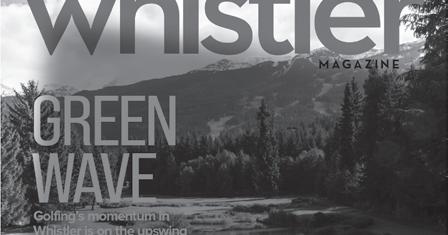
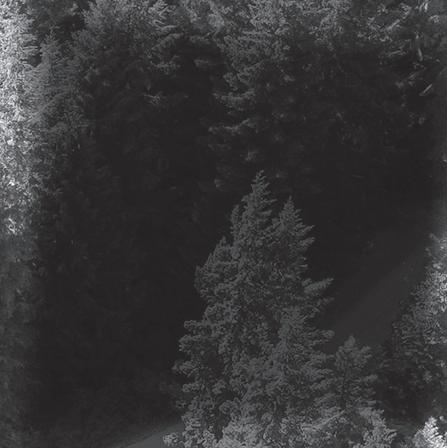




Full-time,part-time&tempjobs. Nocost,nostrings.604-905-4194 www.whistler-jobs.com




The District of Squamish is seeking casual on-call Custodians to join our dynamic team! The ability to work independently and a strong safety mindset is essential.
We offer a competitive wage of $24.57 per hour, flexible schedule and opportunities for development. This role is perfect for all ages especially if you have availability.
This position is casual on-call but can be busy, cleaning in a variety of District buildings.

Apply today by quoting competition number 22-05 and emailing jobs@squamish.ca




Great opportunity for a super motivated/organized person to excel in the field of lock technician services and access control solutions.

The successful individual will have experience in carpentry and/or building maintenance. Any experience in low voltage electrical and/or hotel card access systems will prove very beneficial. Good communication and customer service skills as well as a strong work ethic are essential to this position. Please reply to Service@alpinelock.com with a resume and cover letter outlining your suitability and qualifications for the position.
No drop-ins or phone calls please, apply only by email.
Our ideal candidate:
∞ Previousaccountspayableexperiencepreferred

∞ Exceptionalinterpersonalandorganizationalskills
∞ Accurateanddetail-oriented
∞ Excellentverbalandwrittencommunicationskills
∞ Abilitytomulti-taskandeffectivelymeetdeadlines
What we offer:
∞ Brandnewaffordablestaffaccommodation
∞ Competitive wages and benefits
Join our team of Plumbers and Gas Fitters

Hiring 3rd and 4th year apprentice or journeyman candidates with experience in service/repair work.
• Offering competitive wages

• Providing fully stocked truck, tools, and phone
• Extended health plan available.
• We can hire skilled foreign workers and support permanent residency applications.
• Short-term accommodation availablefree of charge. Long term housing options available as well.
Send your resume to: Dough@spearheadsph.com
Looking to contribute to your local community?

Consider a career in local government. Join the SLRD’s team of dedicated staff who work together to make a difference in the region.
Headquartered in Pemberton, the Squamish-Lillooet Regional District (SLRD) delivers a wide range of regional, sub- regional and local services to its residents. The SLRD is a BC Regional District consisting of four member municipalities (Squamish, Whistler, Pemberton, Lillooet) and four electoral areas. Services include land use planning, solid waste management, building inspection, fire protection, emergency preparedness, 911 services, recreation, water and sewer utilities, regional transit, trails and open spaces as well as financial support for various community services. The region contains some of the most spectacular forests, waterways, and mountains in the province and affords an endless range of opportunities for outdoor adventure, making it an exceptional place to live, work and play.





The SLRD is currently accepting applications for the following positions:
• Legislative Assistant (Regular, Full-time)
• IT Manager (Regular, Full-time)
• Environmental Coordinator (Regular, Full-time)
The SLRD offers a competitive compensation and extended benefits package, participation in the Municipal Pension Plan, a compressed work week (nine-day fortnight), hybrid remote work opportunities, and learning and career development opportunities.
For more information on these career opportunities, please visit www.slrd.bc.ca/ employment. To apply, please submit a cover letter and resume (preferably in pdf format) by email to careers@slrd.bc.ca
We sincerely thank all applicants for their interest, however, only those shortlisted will be contacted.
Vacasa’s forward-thinking approach and industryleading technology help set us apart as the largest full-service vacation rental company in North America. We are seeking individuals with a passion for providing exceptional vacation experiences for our Owners and Guests.

We offer competitive wages and benefits: Travel allowance for Squamish/Pemberton-based employees OR Ski Pass/Activity allowance, Extended Medical, RRSP match, Fun & Safe Work Environment-Great Team, opportunities to grow and more.
Guest Service Agent
Assistant Housekeeping Manager Lead Housekeeper Maintenance Technician
Apply online today!
https://www.vacasa.com/careers/positions or email: paul.globisch@vacasa.com or call to find out more details at 604-698-0520
We thank all applicants for their interest but only those selected for an interview will be contacted.
For more information on all we have to offer, please visit www.evrfinehomes.com or send your resume to info@evr finehomes.com



Wastewater Treatment Plant (WWTP) Operator Full Time, Permanent (CUPE 2010)

Responsible for the operation and maintenance of our Class II Waste Water Treatment facility, we’re looking for candidates who are comfortable working independently and understand the health and safety measures related to WWTP operations.
Join the Village of Pemberton team and give back to this incredible community by being a part of the exciting projects taking place throughout the Village. In addition to the satisfaction of giving back to the community, take a look at what our benefit package has to offer for all full time, permanent staff:




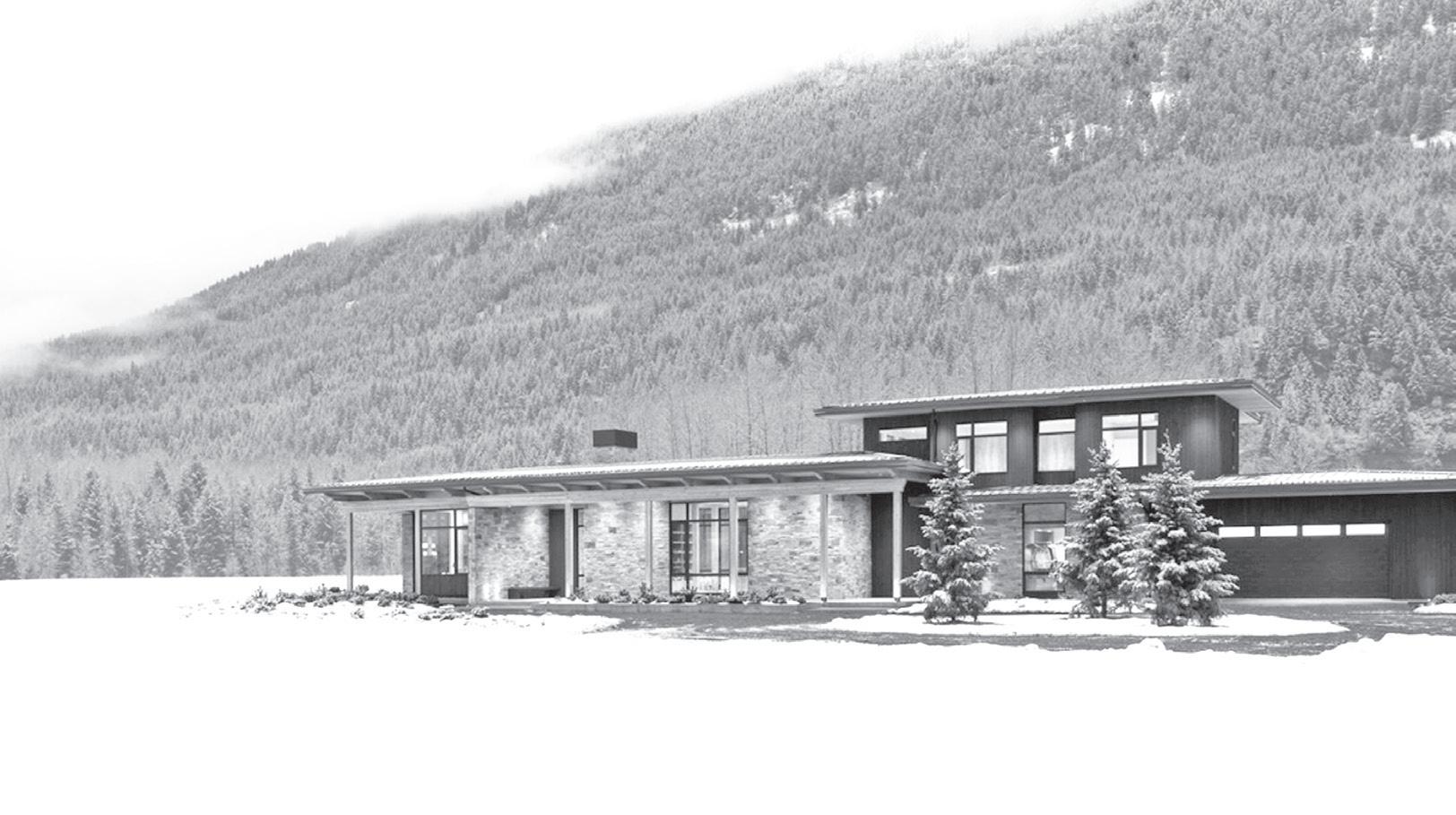


9-Day Fortnight - BC Municipal Pension Plan - Extended Medical Benefits - Dental Coverage - Vision Benefits - Free Fitness Centre access - Keeping it Active Allowance

Interested? Send your resume to recruiting@pemberton.ca. For a full job description or to learn more, visit pemberton.ca/employment.



Reporting to the Director of Finance, the Financial Reporting Manager will be responsible for all areas relating to financial reporting. The Manager’s role & duties will ensure accurate and timely financial statements in accordance with Generally Accepted Accounting Principles and best practices. This position will review operating procedures, company controls, and compliance measures to determine any potential hazards or breaches of conduct. This role will also provide support to the Directors.
The Assistant Health Director is responsible for providing the overall leadership, direction, and management for the planning, development, implementation and administration of Maternal Child Health, Patient Travel, Assisting Living, Pq’usnalcw Health Center and Lil’wat Health and Healing Center, Programs and Services.

politics and First Nations issues while working with a team based in North America’s premier mountain resort.

The successful candidate will be tasked with covering the Lil’wat Nation and the Village of Pemberton—neighbouring communities with a unique relationship, both of which are growing substantially year over year.

The candidate will produce 8-10 relevant news stories per week, as well as at least four cover features during an initial one-year term of employment. The role includes some evening and weekend coverage, and the successful candidate will be required to be in the Mount Currie and Pemberton area regularly.
You have a degree in journalism, are passionate about news and politics, and have a sense of what makes a compelling local news story. You seek to engage and inform your community in print and online platforms, and use social media effectively. You are self-motivated, efficient and deadline driven, with a curious, critical mind and an acute attention to detail. You are able to work well both on your own and with a team.
Ideally, you have experience in covering First Nations, municipal council, elections, and governments at all levels. Other relevant skills include copy editing, long-form feature writing, video editing, and Instagram posting and story creation.
The stories you produce will be shared on Pique Newsmagazine’s website and social channels, as well as those of our sister publications and through other news outlets as part of the federal government’s Local Journalism Initiative.
This is a 12-month position funded through the federal government’s Local Journalism Initiative.
Located in the mountain resort town of Whistler, British Columbia, Pique Newsmagazine is the unequivocal leader in reporting, interpreting and understanding the culture of the Coast Mountains and what it means to those who live, work and play in Whistler.

At 29 years young, we’ve established ourselves as the locals’ publication that is inquisitive and edgy, provoking conversation and building community. With our peers we’re acknowledged perennial winners at the BC & Yukon Community Newsmedia Awards (BCYCNA) and Canadian Community Newsmedia Awards (CCNA) for general excellence and reporting categories, as well as several Webster Awards honours over the years.
We’re known for our unique artsy design, weekly long-form features and comprehensive news coverage, but of course our reach is global, with loyal readers from all over the world who come to piquenewsmagazine.com daily for the best Whistler storytelling and news source.
To apply, send your resume, clippings, or other relevant materials, as well as a cover letter making the case for why we should hire you, by 4 p.m. on July 28th to : Braden Dupuis at bdupuis@piquenewsmagazine.com

All Departments
Bylaw Enforcement & Animal Control
Community Planning
Engineering
Facilities
Fire Rescue
Public Works
RCMP
Recreation




• Building Official - Plan Examiner
• Building Official - Plumbing Inspector
• Corporate Service Administrative Coordinator
• Labourer II - FireSmart
We offer competitive wages, a comprehensive pension plan and health benefits, and we are driven by our passion to serve community.
• Clerk 2 – Casual/ On-Call
• Community Patrol Officer – Casual/On-Call (Multiple Positions)
• Plan Examiner 2 – Regular Full-Time
• Manager of Environment - Regular Full-Time
• Engineering Technician – Regular Full-Time
• Custodian – Regular Full-Time
• Fire Chief - Regular Full-Time
• Utilities Technologist – Regular Full-Time
• Detachment Clerk – Casual/On-Call
• Lifeguard 1 – Regular Part-Time (20-30 hours)
• Recreation Program Instructor 1 – Biking – Casual/ On-Call (Multiple Positions)
As an equitable and inclusive employer, we value diversity of people to best represent the community we serve and provide excellent services to our citizens. We strive to attract and retain passionate and talented individuals of all backgrounds, demographics, and life experiences.
• Lifeguard/Swim Instructor
Resort Municipality of Whistler
• Program Leader - Myrtle Philip Community Centre
• RCMP Records Team Lead
· Lifeguard/Swim Instructor
· Legislative and Privacy Coordinator

• Recreation Cashier/Receptionist
· Skate Host
· Program Leader
• Skate Host
· Wastewater Treatment Plant Process Supervisor
· Lifeguard/Swim Instructor
· Solid Waste Technician
· Labourer I – Village Maintenance
· Accountant
• Supervisor, Utilities - Wastewater
· Youth and Public Services Specialist
Resort Municipality of Whistler whistler.ca/careers

JOIN THE TYAX FAMILY


Come work for one of Canada’s most unique destinations and check a bucket list job. Currently looking for:
Experienced Cook | Lodge Cook | Dishwasher
Why work for Tyax:
• Deeply subsidized, modern townhouse-style accommodation.
• Three complimentary meals per day.
• Staff use of spa facilities, gym and sports equipment.
• Opportunities to go heliskiing during the winter.

• Don’t pay premium for your cost of living.
• Get a job where you can really put some money aside for your travel plans.
• Experience the amazing true Canadian wilderness.
• Join a fun and welcoming diverse team from all over the world.
• Work for a family size company where team members truly come first.
• 2 consecutive days off per week to enjoy what the region has to offer.
tyax.com/employment careers@tyax.com
The Pinnacle Hotel Whistler has the following positions available: PLAY
• ROOM ATTENDANTS
• HOUSEMAN AM/PM
Please reply by email: parmstrong@pinnaclehotels.ca
About Us: SSHS is a non-profit Indigenous Health Organization dedicated to improving the health and well-being of Indigenous communities. Our organization provides culturally appropriate healthcare services, programs, and initiatives to support the holistic health of Indigenous individuals and families.
JOB POSTING: PROGRAM AND CONTRACTS MANAGER
Position Title: Program and Contracts Manager

Location: Mount Currie, BC (Hybrid negotiable)







Type: Full-time, Permanent
Salary: $70,000 to $85,000, plus benefits (Based on experience)
Benefits: SSHS offers a competitive benefits and employment package for full-time staff
Closing Date: August 31, 2023
Position Overview: Southern Stl’atl’imx Health Society (SSHS) is seeking a highly motivated and skilled full-time Program and Contracts Manager to join our Indigenous non-profit health organization. The Program and Contracts Manager will play a pivotal role in overseeing and managing various programs and contracts and agreements aimed at improving the health and well-being of the four communities that SSHS serves: N’Quatqua, Samahquam, Skatin, and Xa’xtsa First Nations. This position requires exceptional organizational skills, strong leadership abilities, and an indepth understanding of Indigenous culture and health issues. The successful candidate will be responsible for ensuring the effective delivery of programs, managing contracts, agreements, and partnerships, and supporting the organization's mission “to honour the health of The People by working together to deliver holistic health services”.

JOB POSTING: BOOKKEEPER
Position Title: Bookkeeper

















Location: Mount Currie, BC (Virtual or Hybrid negotiable)

Type: Full-time, Permanent
Salary: $48,000 to $52,000, plus benefits (Based on experience)
Benefits: SSHS offers a competitive benefits and employment package for full-time staff
Closing Date: August 31, 2023
Position Overview: We are seeking a detailoriented and experienced Bookkeeper to join our team. As the Bookkeeper, you will be responsible for helping manage the financial records and transactions of our organization, ensuring accuracy, compliance, and financial stability.
JOB POSTING: MEN’S HEALTH LEAD
Position Title: Men’s Health Lead



Location: Mount Currie, BC
Type: Full-time, Contract


Salary: $53,000 to $60,000, plus benefits (Based on experience)
Benefits: SSHS offers a competitive benefits and employment package for full-time staff
Closing Date: August 31, 2023
Position Overview: SSHS is seeking a motivated Men’s Health Lead to promote health and healing amongst Stl’atl’imx community members through: providing a safe and supportive environment for men to gather and share stories; supporting, mentoring, and bringing together Stl’atl’imx men to develop leadership skills and peer support networks that empower and encourage culturally safe healing and wellness; promoting Stl’atl’imx traditional and cultural ways; leading, organizing, and facilitating participation in traditional activities (including but not limited to gatherings, hunting, fishing, harvesting, building, etc.) that incorporate land-based healing and therapy, and harm reduction strategies; providing information about and facilitating access to mental wellness and substance use support services; and culturally aware training around mental wellness, suicide prevention, addiction, harm reduction, etc.

For a list of all position responsibilities, qualifications and any other special requirements, please refer to www.sshs.ca or our Facebook page: Southern Stl’atl’imx Health Society for an exhaustive job description.
Please submit resume and cover letter by email to Julia Schneider, Executive Assistant to the Interim Health Director, at julia.schneider@sshs.ca.
Please include in the subject line your name and the position you are applying for.






















Enter a digit from 1 through 9 in each cell, in such a way that:
• Each horizontal row contains each digit exactly once
• Each vertical column contains each digit exactly once
• Each 3x3 box contains each digit exactly once Solving a sudoku puzzle does not require any mathematics; simple logic suf ces.

LEVEL OF DIFFICULTY: MEDIUM MEDIUM#26
Solution, tips and computer program at www.sudoku.com



ANSWERS ON PAGE 51

I CURRENTLY have some alien life form living on some of my Saskatoon berries. It looks eerily like a Covid virus—round and spiky, with microscopically small, cauliflower-like ends. I was pretty sure it was alien, but it turns out to be terrestrial. Something called, appropriately obscure and no doubt Latin, gymnosporangium nelsonii, or, in English, Saskatoon/juniper rust.
One of the reasons I was suspecting alien lifeforms is because in 22 years I’ve never seen it before. The many Saskatoon bushes at Smilin’ Dog Manor have never before been invaded. And I don’t have any nearby juniper from which the fungus originates.

And believing an extraterrestrial is the cause is, well, trendy.
BY G.D. MAXWELLThere are many intractable issues facing our neighbours to the south: climate change, culture wars, Donald Trump, and a host of others. There is, however, only one burning issue that seems to have bipartisan support in the U.S. Congress—getting to the bottom of whether the U.S. has been visited by aliens.
Late last month, hearings were held by the National Security Subcommittee of the House Oversight Committee to delve into the question of whether there is intelligent life outside Earth—though perhaps they should have limited that query to Earth itself—and if so, have aliens visited this planet and is that visitation being covered up... and by whom?
Well, duh. The answers are yes, no, and don’t be absurd.
Is there life elsewhere in the universe? The odds of there not being some form of life are highly unlikely. Best guess by the best guessers is there are something like 200 sextillion—200 billion trillion—stars in the universe. While no one’s counted them, or even seen them, I’m not about to, so I’ll take their word for it. Whether they’re off by a few billion trillion doesn’t really matter. The law of large numbers, and the fact they found the distinct possibility of some form of life on Mars, is good enough for me. Life? Sure.
Intelligent life? By what measure?
Since 1984, the SETI Institute has been searching for evidence of extraterrestrial life. So far, zilch. Some radio signals, some speculation, no little green men or Top-40 alien tunes. During the same period, Earth has been bombarding deep space with probes and old reruns of Gomer Pyle, U.S.M.C., hoping someone else would tune in way out there.
The uber-hyped speaker before the House subcommittee, David Grusch, told members the Pentagon was not only in possession of crashed alien space ships, but also biologics—that is, aliens, or whatever was left of them once their vehicles crashed into Earth.
Mr. Grusch did not show up wearing a foil hat. He did come with impressive credentials, having racked up time during his career with the U.S. National Geospatial-Intelligence

Agency, the National Reconnaissance Office, and something called the Unidentified Aerial Phenomena Task Force, the members of which may wear foil hats.
And heck, he’s seen the evidence! Oh, no. I take that back. He hasn’t seen the evidence, but he’s been told about it by people he says have seen it but he can’t name because... you know. It would spoil a good story.
I’m not conceited enough to believe there isn’t life elsewhere in the universe. I’ll even grant there may be, probably is, intelligent life out there. But I have some fundamental problems with the notion they’ve physically visited this planet. Some of those problems are physical, some behavioural, all are tinted by human experience.
For all our, which is to say, human,
levitate materials likely not found in usable forms on whatever planet they’re from.
It suggests a span of time for their civilization far longer than our own. It suggests a means of locomotion powerful enough to laugh at gravity and achieve warp speed.
More importantly—especially if our own evolution of locomotion is anything to go by— it suggests they didn’t poison their own habitat during the time it took to reach such breakthroughs, and they overcame very real social issues along the way that allowed them the luxury to spend the effort to overcome the limitations of space.
But wait, there’s more.
Three nagging questions about Mr. Grusch’s little green people. Why is it, if aliens have been visiting long enough to crash into
fighter pilots who testified to having seen inexplicable, mysterious flying things—now called unidentified aerial phenomena in a comical attempt to de-sci-fi flying things.
I believe them. Heck, I’ve seen flying things I couldn’t identify. And I totally believe the U.S. military would move heaven and Earth to deny any knowledge about them, spin any story to explain them—remember marsh gas?—and construct an elaborate cover-up to hide them.
Why? Because those flying things were theirs, and they don’t want to admit it. Because those flying things were launched by some other country, and they don’t want to admit it. Because their very sophisticated tracking systems didn’t/don’t pick them up, and they don’t want to admit it. Or just because they
intelligence, we haven’t ventured very far into space. Even travelling to the edge of our own solar system—let alone galaxy—is either going to be a multi-generational trip, or we’re going to have to figure out how to travel faster than light... assuming that’s possible.
Aliens, while not necessarily looking anything like us or, as science fiction writers like to posit, not even being carbon-based lifeforms, would, nonetheless, have to have the ability to construct any spacecraft they crashed into Earth. That, at a minimum, suggests delicate articulation and opposable digits. Or one heck of a powerful ability to
Earth, it’s only North America, and only the U.S., they’ve had such dire luck to crash into?
Why, with the advent of modern recording equipment—everything from iPhones to sophisticated tracking technology—are there no verifiable recordings?
And most damning, in a society that can’t manage to keep anything secret, how has such a cover-up, requiring huge numbers of people to keep quiet for so many years, been as successful as it seems to have been? Notwithstanding everything else, I consider that to be a knock-out punch.
There were also a couple of Top Gun U.S.
like keeping secrets so they can keep the gravy train rolling. Or all the above.
Perhaps the congressfolks just needed a little levity in their lives, or thought we needed a little levity in ours when they decided to hold public hearings on UAPs. Perhaps it was the only thing they could agree on before the House Republicans went back to their own cover-up that Trump really is an alien and the House Democrats went back to finding new ways to undermine their 2024 presidential hopeful.
But with any luck, they’ll continue to seek out intelligent life... in Washington. ■
Why is it, if aliens have been visiting long enough to crash into Earth, it’s only North America, and only the U.S., they’ve had such dire luck to crash into?
4653 213 G2 Blackcomb Way: Rarely available back-to-back weeks in the Horstman House on Blackcomb. This quiet 1 bedroom offers owners the perfect home away from home with the option for nightly rental managed by the front desk.

$209,000
Nick Swinburne prec*
604-932-8899
222-4369 Main Street: Incredible revenue generating property in the heart of Whistler. One of the largest studio units in the Alpenglow. One of only four units with an oversize deck. Don’t sleep on this opportunity. www.kenach.com.


$689,000
Ken Achenbach
604-966-7640
#204 4360 Lorimer Road: Marketplace Lodge offers the ultimate Whistler location! Flexible zoning permits short and long term rental and unlimited owner use. This one bdrm plus den has two full baths, an open floorplan, fireplace, south facing deck and underground parking. No GST! $1,175,000 Laura Wetaski 604-938-3798
7471 Urdal Road, Pemberton: Development Opportunity!

Nestled in the heart of Pemberton, this remarkable 10-acre property boasts a prime location only 750 meters from the village centre shops and services, breathtaking 360-degree views, and endless possibilities. $6,495,000
Steve Legge prec*
604-902-3335
4660 325 Blackcomb Way: Steps from Lost Lake and The Fairmont Chateau Golf Course, enjoy resort amenities like a heated pool, hot tub, exercise room, and owner lockers in this two-bed corner unit. Convenient access to Whistler Village. Year-round usage or earn from nightly rentals. $1,625,000

Sam Surowy
604-902-9754
1307 Eagle Drive, Pemberton: This new 4br/6ba home enjoys unobstructed views up the Pemberton Valley, a 30’x40‘ rooftop patio for gardens, hot tub and entertaining; 1br suite, large flex room, radiant heating, workshop, double garage and much more! Call for a private viewing. $2,590,000 Rob Boyd – Boyd Team 604-935-9172

2732 Millars Pond: This 5 bed/3.5 bath chalet is located in a secluded family neighborhood steps from a park.Enjoy ample sunlight, vaulted ceilings, a wood burning fireplace, gourmet kitchen, laundry room, a 2 car garage & a large family room as well as a two bed revenue suite. Employee restricted. $2,799,000 Allyson Sutton PREC*
604-932-7609
#314 4360 Lorimer Road: Best-priced nightly village rental property. This beautifully renovated studio boasts a top-floor location with full kitchen, cozy living room, gas fireplace, brand-new furniture, flooring & appliances. Perfect for weekend getaways or nightly rentals. $825,000 + GST


Jody Wright 604-935-4680
#47 4000 Sunstone Way, Pemberton : New in 2021, this beautiful 3 bed/3 bath duplex boasts designer finishes, A/C & sun drenched deck with mountain views. Open concept, perfect for entertaining & a double garage is fully outfitted to organize all your tools and toys. GST Exempt. $1,459,000
Janet Brown 604-935-0700
